

EASY! 3 Steps to the Perfect Leak Proof Bag Science Experiment
Categories STEM Activities
We’ve done a lot of quick STEM activities. We’ve even done the leak proof bag science experiment before, although we gave it a twist as a brain surgery leak-proof bag!
But this time, we were doing a collection of pencil science experiments, so I knew we needed to add the classic quick science experiment to the list.
So, we gathered some number 2 pencils and got ready to do our leakproof bag experiment!
If you want to do this experiment at home or in the classroom, it is best suited to the outdoors, as the bag does eventually leak when you take out the pencils.
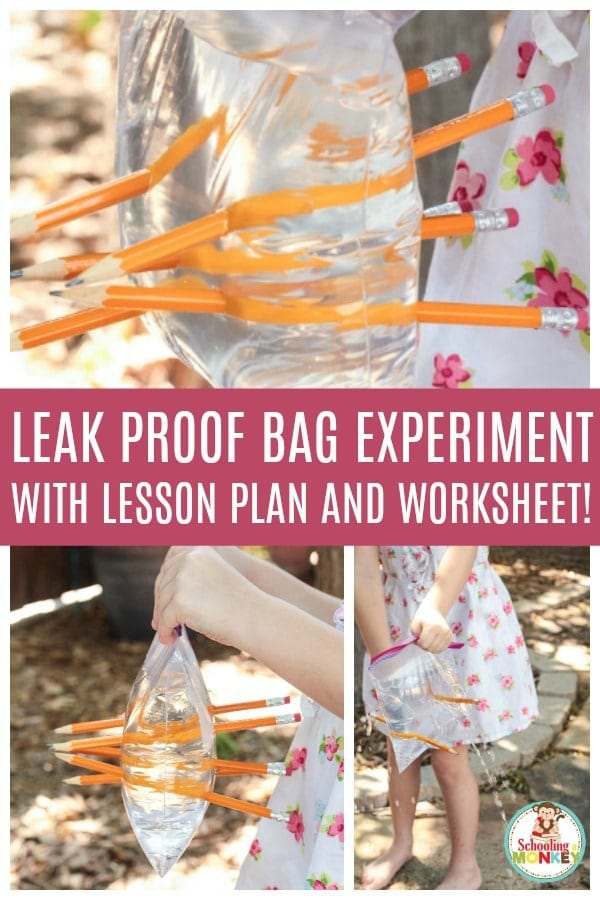
So, to avoid a huge gush of water on your floor, do it outside!
If you can’t do it outside, you can do the experiment over a large bin to catch any drips.
Leakproof Bag Science Experiment Lesson Plan
Want to turn the leak proof bag science experiment into a complete lesson? Just add these elements to your science time:
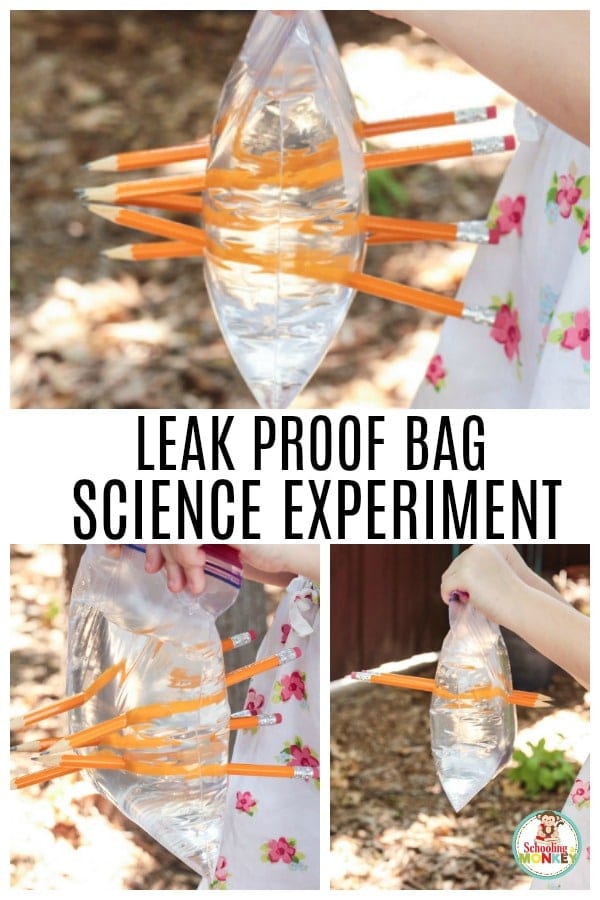
Experiment Variations
Any science experiment should include variations on the “right” answer. For this leak proof bag science experiment, you might try sticking other objects through the bag (like crayons or bamboo skewers) to see which one produces the least amount of leaks.
You can also test the activity with other types of materials. Does the same thing happen when you use a cloth bag? What about a different kind of plastic? Paper?
Science Explanation
Before or after doing the experiment with the kids, have a period where you discuss the science behind the lesson. This is a good resource for exploring the chemistry of polymer chains. Depending on the age of the children doing the experiment, you can explore the chemistry completely or simplify it.
I did this experiment with my kindergartner, and she was interested to learn the details of the experiment in the section below, but she was not ready for a full high-school level chemistry lesson!
Data Recording and Analysis
All good scientists know that data recording and analysis is crucial to any scientific discovery. What this looks like will depend on the grade level of the child. A young child might draw a picture of the results and write a word or two.
Older kids can write the chemical formula for polymer chains and analyze what kind of bond each type of material tested has.
No Leak Magic Bag Science Explanation
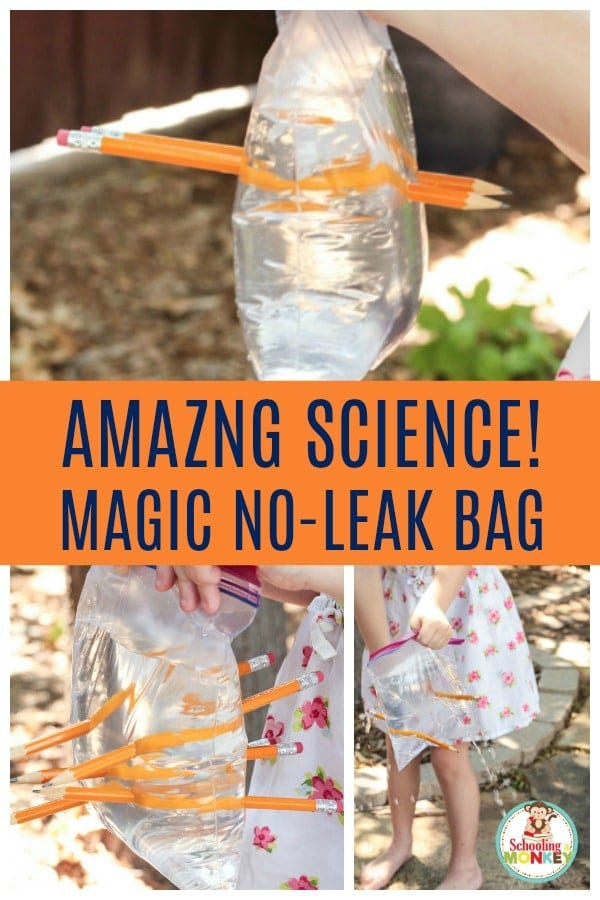
Do you know why the no leak magic bag works? It’s because of science! Plastic baggies are flexible because they contain long chains of molecules that can bend and flex. If plastic bags did not have polymer chains, the plastic would be hard and inflexible.
But, because these chains are so flexible, when you pierce the bag, the molecular chains in the plastic flex around the pencil inside the hole, creating a tight seal around the pencil and preventing the water from escaping (although you may have a few minor leaks).
When you remove the pencils, the polymer chains can’t move enough to fill the holes, so the water escapes in a fun fountain.
Supplies to Make a Leakproof Bag
You need just a few supplies for the leak proof bag science experiment, which makes it even easier to do! You’ll want to have one bag for every student and about 4 pencils per student.
You can also have your students do the activity in groups of 3-4.
This post contains affiliate links.
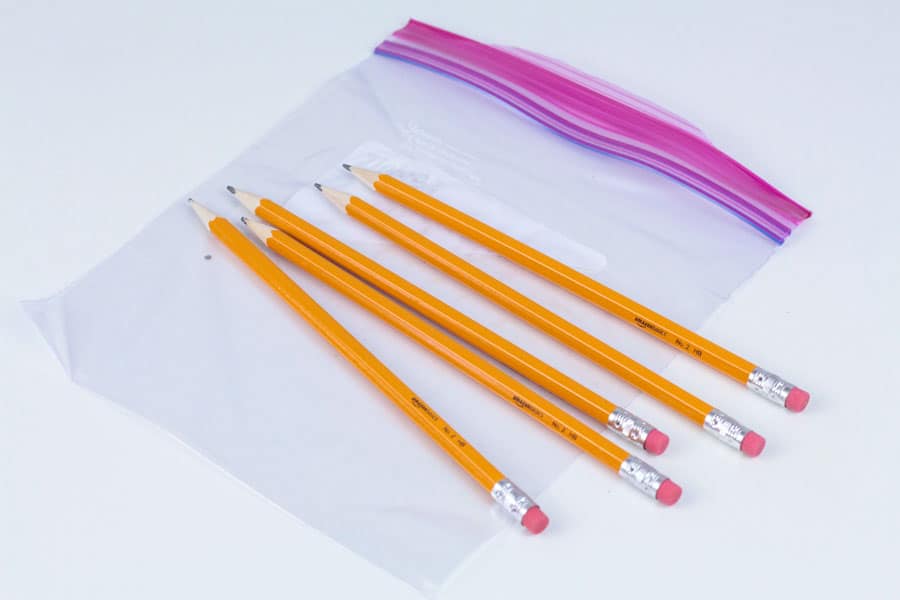
You will need:
- Quart sized plastic baggies
- Number 2 pencils (I like to use pre-sharpened pencils )
- A large plastic bin (if you’re doing the experiment indoors)

How to Do the Leakproof Bag Experiment
This experiment is so easy to do!
First, fill the plastic bags with water and seal them tightly.
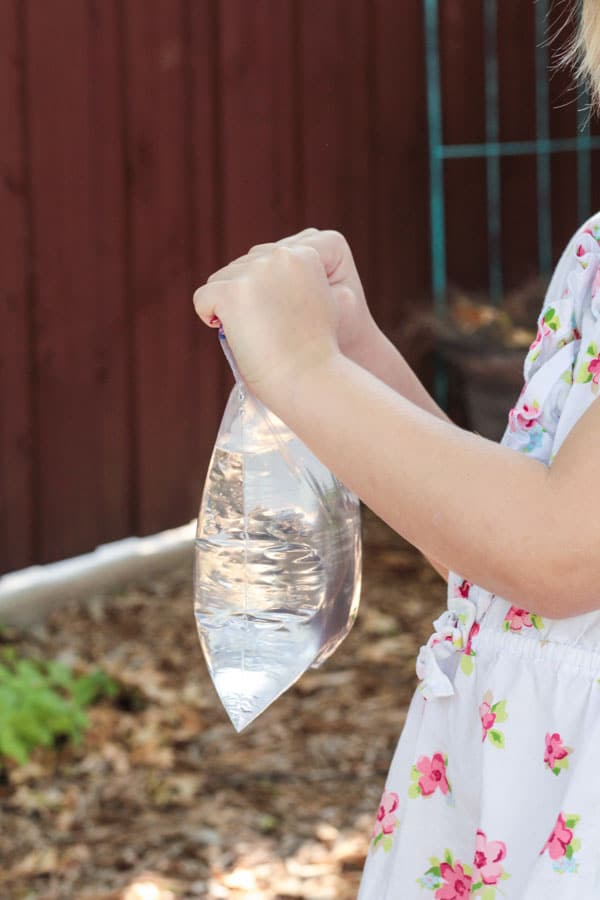
Next, take the bags outdoors or hold them over the bin.
Ask the kids what they think will happen when you put the pencil through the bag. Many of them will think that the bag will leak right away.
Quickly pierce both sides of the bag with the pencil. If you take too long, the bag will leak.
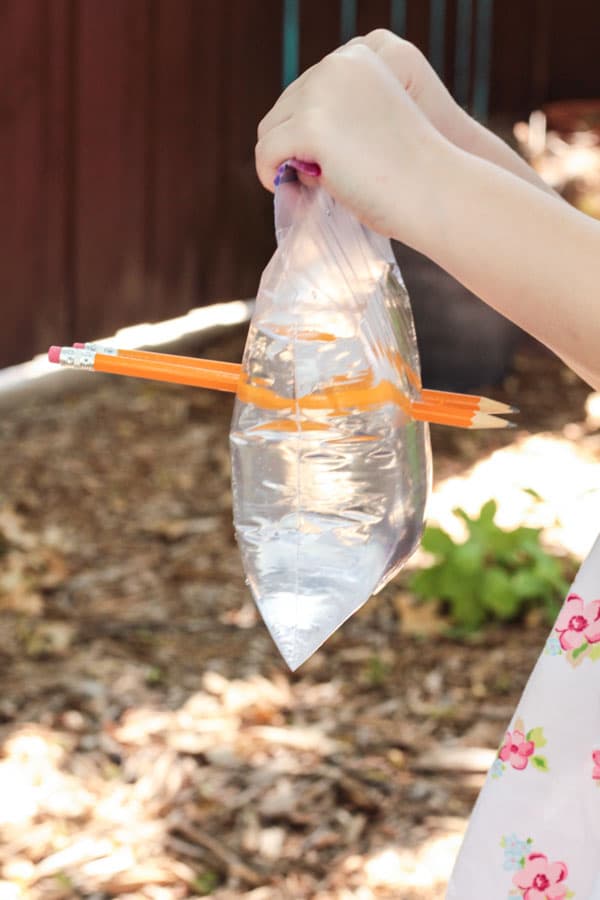
Show the kids how the pencil has gone through the bag, but the bag isn’t leaking!
This is a good time to talk about the science behind the lesson.
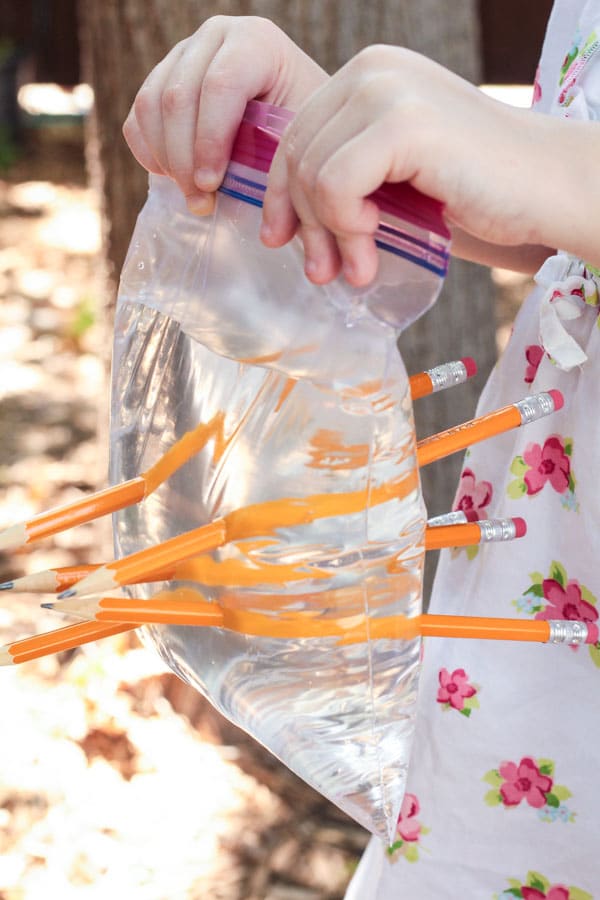
Ask the kids what they think will happen after you remove the pencil.
Let the kids remove the pencils.
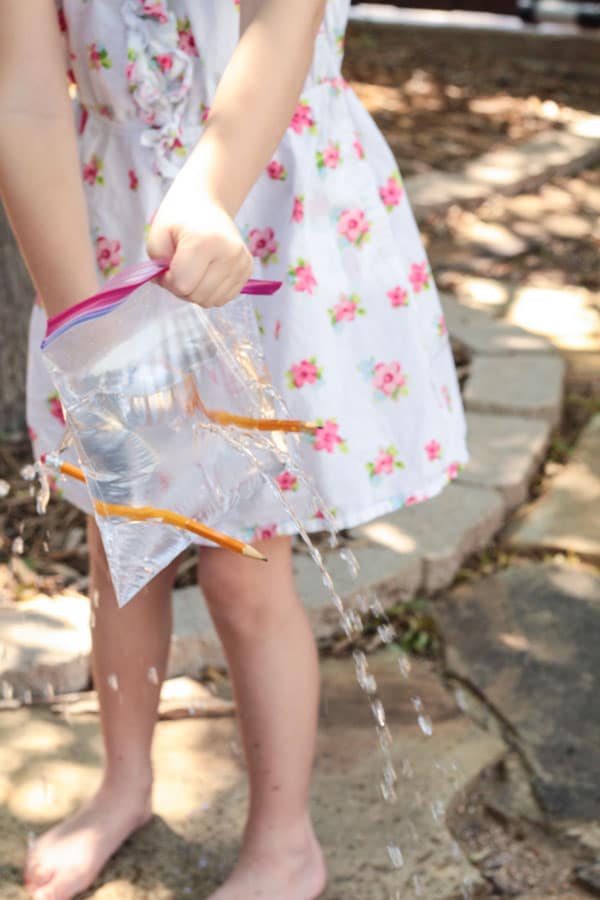
The water will escape right away.
Have the kids repeat the experiment with your other materials, and record their results on a science worksheet.
More Quick STEM Activities to Try
Milk Surface Tension Science Experiment
Liquid Density Jar Science Experiment
Cool Science Experiments in Mason Jars
Unicorn Coding Coloring Pages
Share this project with a friend!

Leak Proof Bag: Quick Science Experiment for Kids
When my kids are bored, we usually try a new science activity. In this case, we had a few minutes to kill and decided to try one of our favorite experiments, the leak proof bag science experiment. This science experiment demonstrates how polymer chains work, and it looks just like magic to little ones. Why won’t the bag leak when it has huge holes in it? Kids will love this mixture of messy play and science and it’s perfect for the combination of curious kids and a warm afternoon.
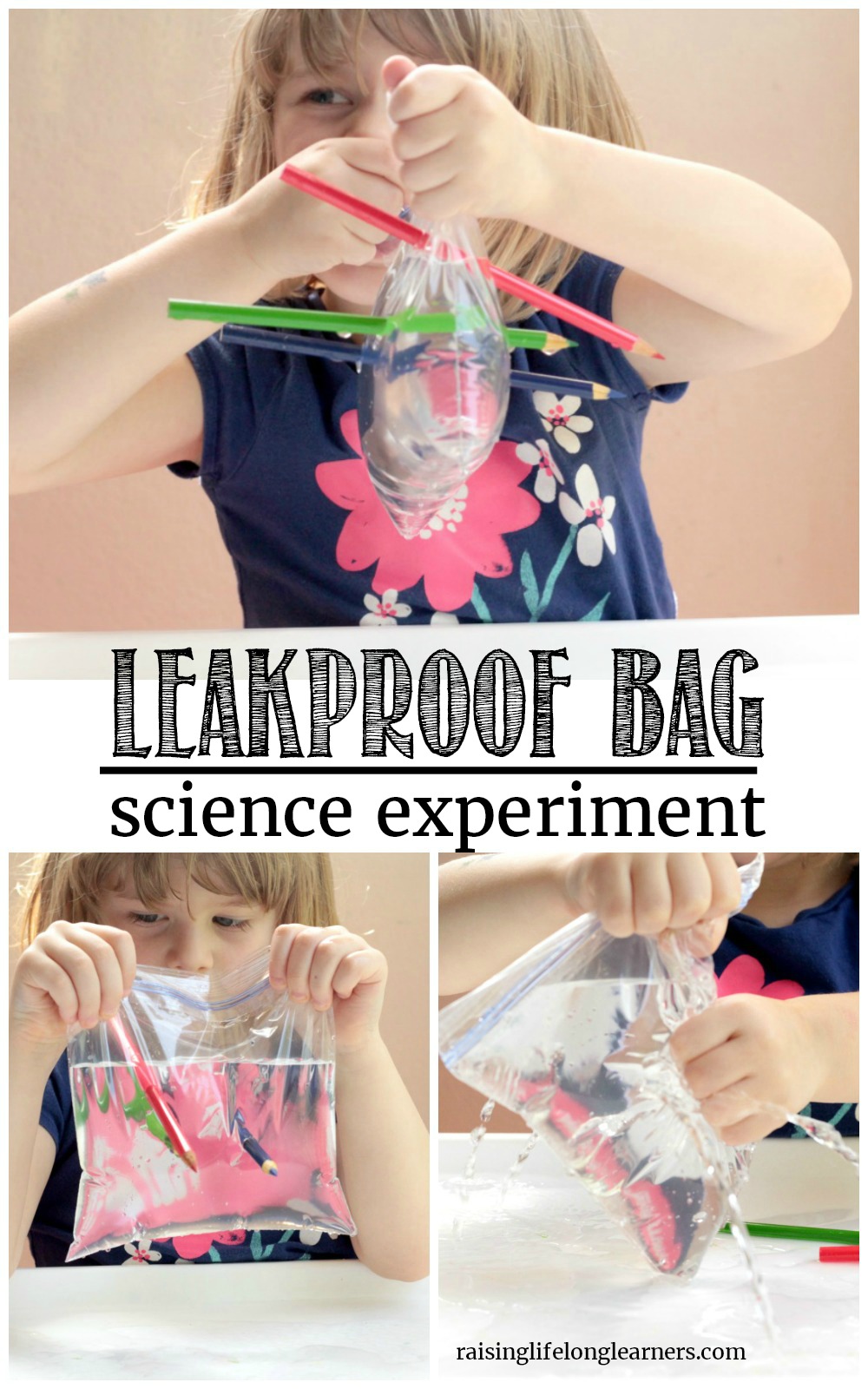
Have a few minutes to kill? Why not try the easiest science experiment ever? The leak proof bag is always a hit with kids, and it’s so easy to do! You’ll need just a few things:

- Sharp pencils
- Plastic baggie
Make sure your pencils are really sharp. If they aren’t, you might get leaks anyway.
Fill the bag with water and seal it up tight.
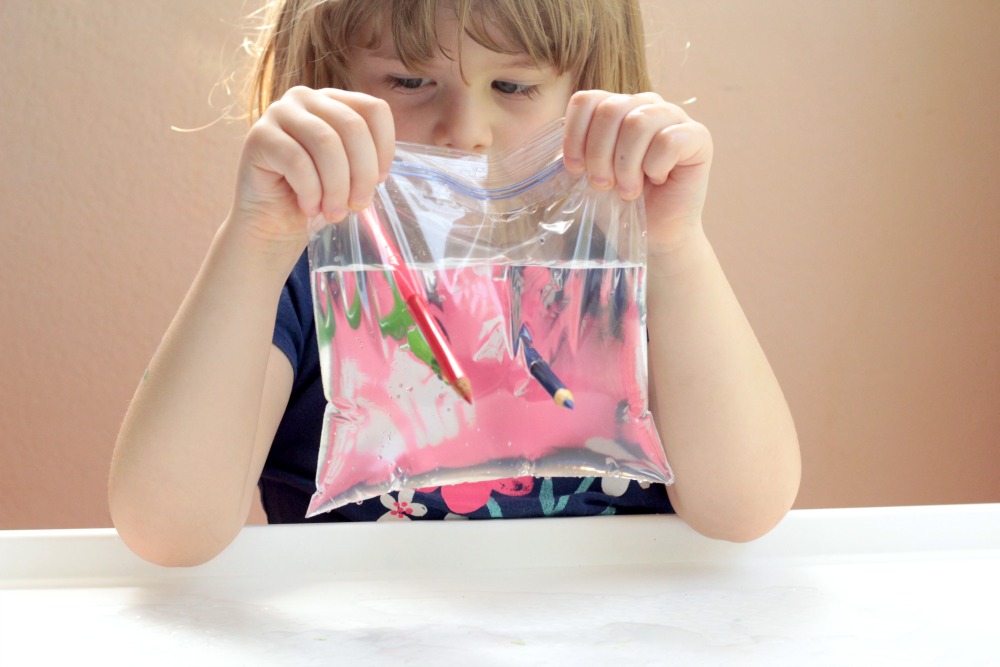
Hold the bag up and tell the kids to poke a pencil through. Some might hesitate, but go ahead and tell them to go for it. If they don’t poke the pencil through with confidence, it might still leak.
Poke the pencil through both sides of the bag.
It doesn’t leak!
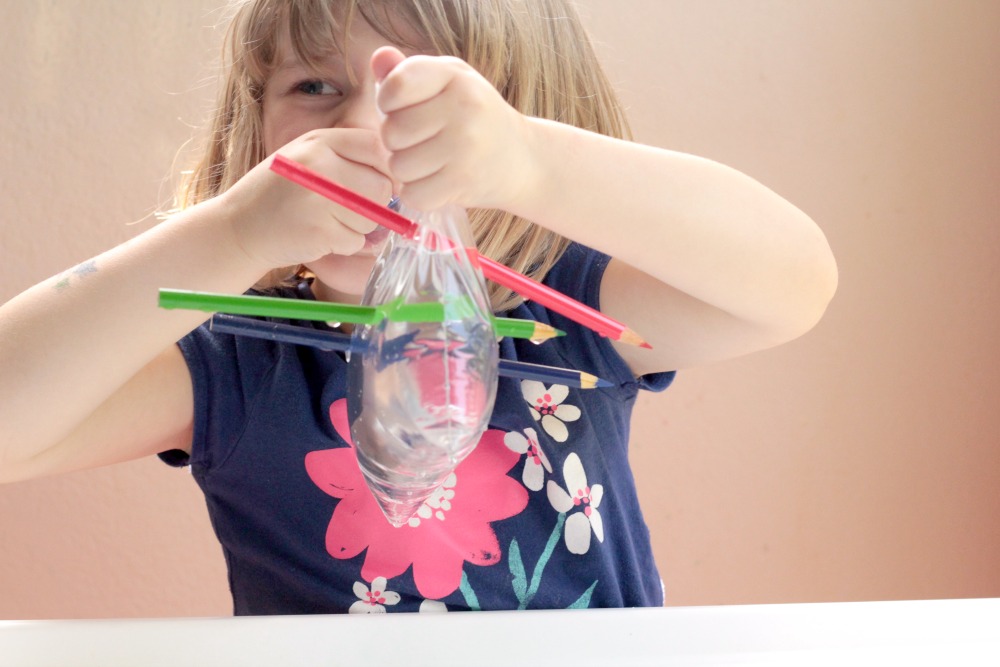
When the pencils are removed, a shower of water leaks out. Use this water to play in, or use it to water the garden!
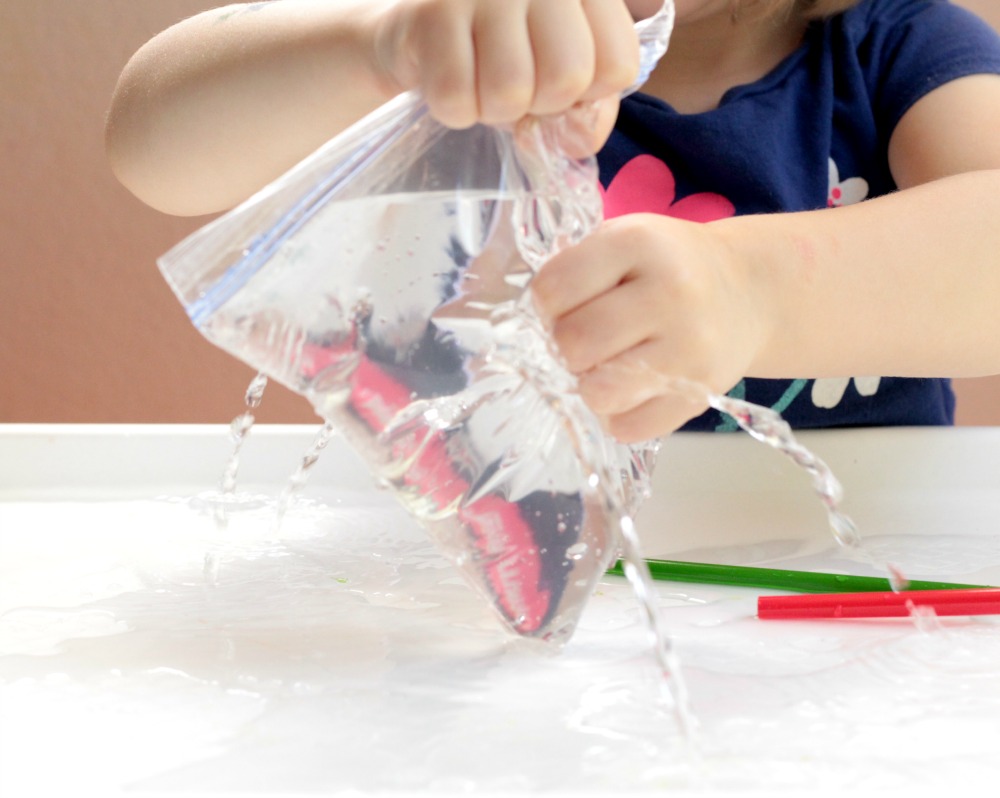
Kids will love trying this activity on a hot day.
Leak Proof Bag Science Explained
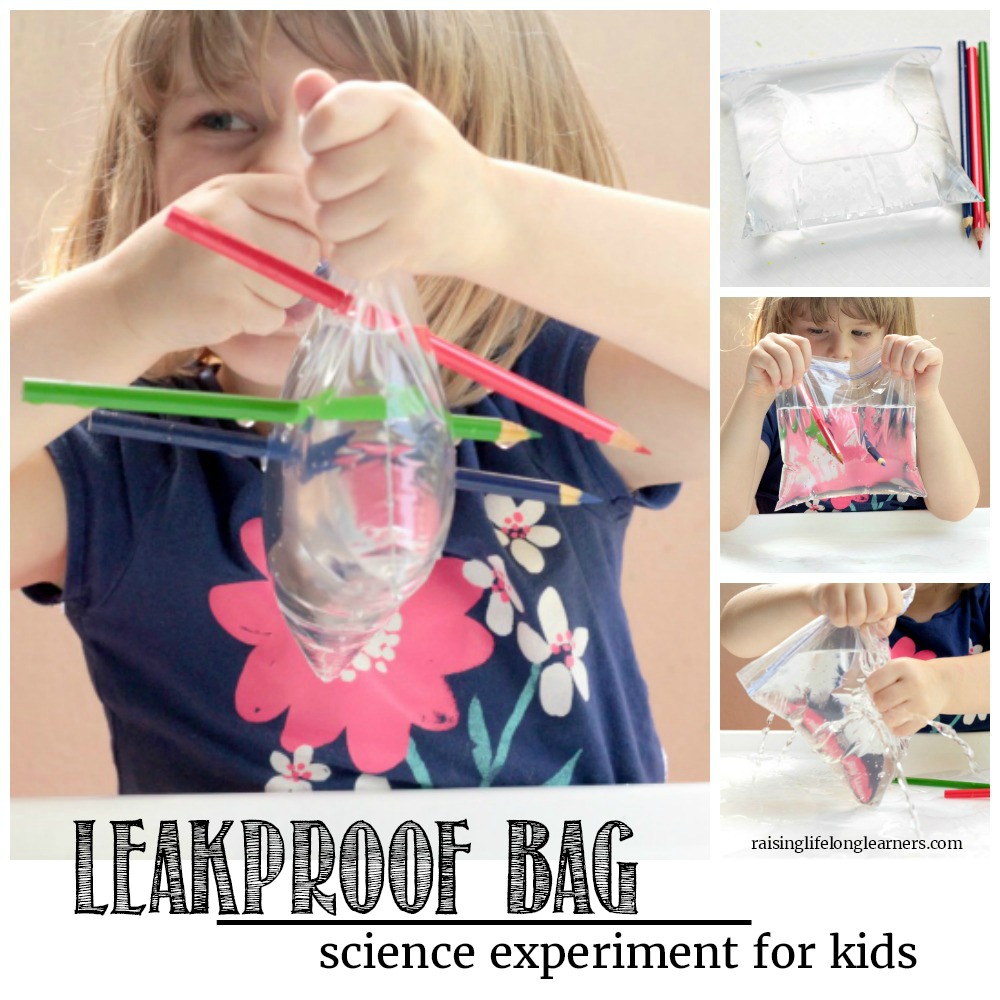
Flexible plastic is made of polymer chains. The polymers have many molecules inside of them. When the pencil goes through the bag, the molecules in the polymer chains surround the pencil, sealing it up tightly and preventing leaks. But when you remove the pencil, the molecules don’t move to seal the hole, allowing the water to escape.

More fun science for kids:

Posted on Last updated: June 13, 2022 By: Author Kim
Categories STEM Activities
Leak Proof Bag Experiment
Leak proof bag experiment for kids. Science experiment demonstrating polymers.
- Ages: Preschool , PreK , Kindergarten
- Difficulty: Easy
- Learning: Scientific Method , Polymers, STEM
Science activities are the best, but it is extra fun when it seems to work like magic. And this STEM experiment is so simple, but huge on the magic factor. (Don’t worry, the explanation is simple too.)
This science activity just needs a resealable plastic bag, water, and pencils. You can do this at home or with any elementary grade at school.
Oh, and kids seem to really like having permission to jab something. That’s a big draw with this activity too.
Let’s do the leak proof bag experiment.
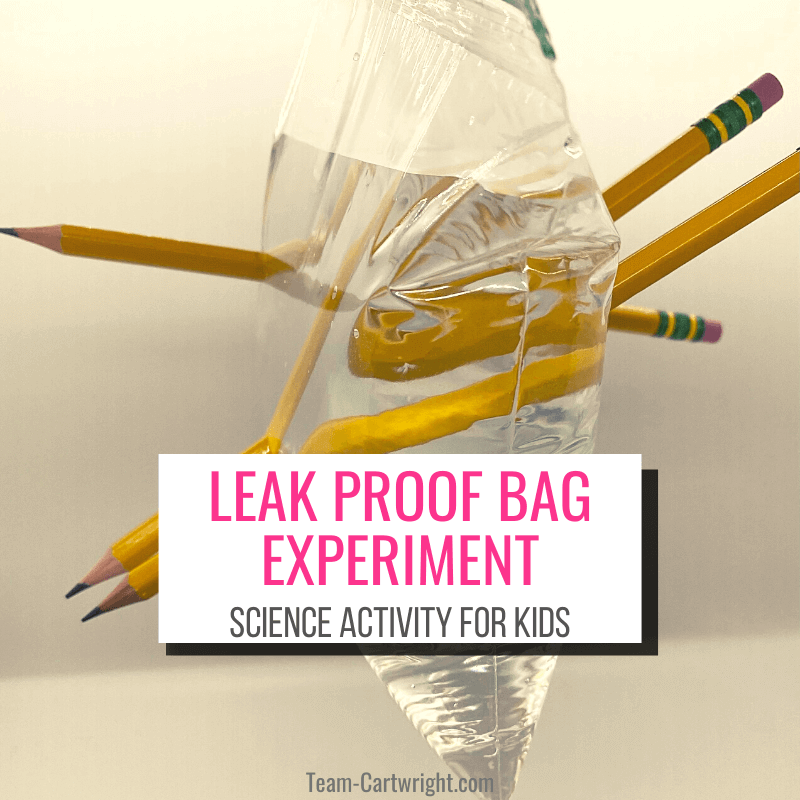
What's In This Post?
Supplies for Leak Proof Bag Science Experiments
Vocabulary to know, utilizing the scientific method, pencil in a water bag experiment, instructions.
This experiment is perfect for busy caregivers. It requires minimal effort but really lets children explore and utilize the scientific method in a very natural way.
Plus telling your kids you’re going to teach them how to put a pencil through a bag of water without spilling will really grab their attention.
(And if you like this experiment, be sure to check out the Exploding Baggie Experiment ! A safe chemical reaction using kitchen supplies and the same type of bags.)
Two things and some water, that’s all you need.
- Sealable Baggie
- Sharpened Pencils
Yep, this is all you need! You can make this work with just one pencil, but having more make this experiment even more exciting.
How To Do The Leak Proof Bag Experiment
This science experiment is deceptively simple. It really only takes about a minute to do, but your child will be fascinated by it for much longer.
Step 1: Fill your resealable baggie with water. You want it to be pretty full, but you can leave a little headspace at the top. Seal up your bag.
Step 2: Stab the baggie with a pencil and leave the pencil in place. Yes, I am serious. No, it won’t leak.
You can add more pencils. When you are ready, go ahead and pull one or more out to see the water leak out of the holes!
You have got to try these fun activities too!
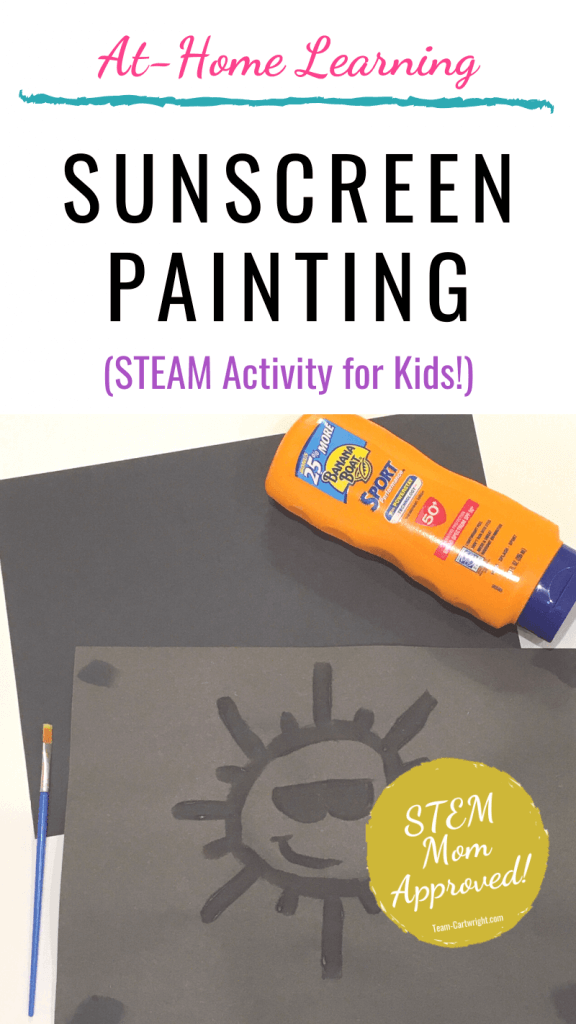
We do have to address safety with this one, as this experiment involves stabbing. This activity requires adult supervision.
Make sure your child knows to only jab the bag and nothing else. Keep the pointy end of the pencil away from anyone’s face.
It might sound counterintuitive, but this activity is actually safer if the pencil you use is sharp. A dull pencil will have a harder time piercing the bag and make it more likely that an injury could occur.
As I wrote in the safety section, be sure to use sharp pencils to make this activity work best.
You can use pens and mechanical pencils as well, along with colored pencils.
Use the gallon size bags if you have them to have plenty of room to add lots of pencils. This really ups the wow factor.
Do this activity over a sink or a large container. If you wiggle the pencils around or pull them in and out a lot there can be some slight leaking. And once you take the pencils out of the bag the water will leak out. Having extra containment or using the sink will limit potential messes.
Clean up for this activity is pretty quick and easy. Pull all the pencils out of the bag. (Hold it over another container or sink for this!) Let the water drain out then throw the bag away.
How The Leak Proof Bag Experiment Works
Let’s dive into the science of this activity. I know it kind of looks like magic, but it is actually a very simple explanation.
The science of this experiment is polymers. The baggie we use is made up of polymers. If we remember from slime making , polymers are long chains of repeating molecules, called monomers.
When we stab the bag with our pencil, the pencil tip works its way between those polymers to make a hole. Once the pencil is in place the polymers surround the pencil. This causes the pencil to act like a cork and no water is able to escape.
Fun fact: One of the most common polymer chains used in plastic bags is high density polyethylene .
There are a few key terms that are helpful to mention to your kids.
- Polymer – large molecules made of up chains of monomers
- Monomers – small molecules that make up polymers
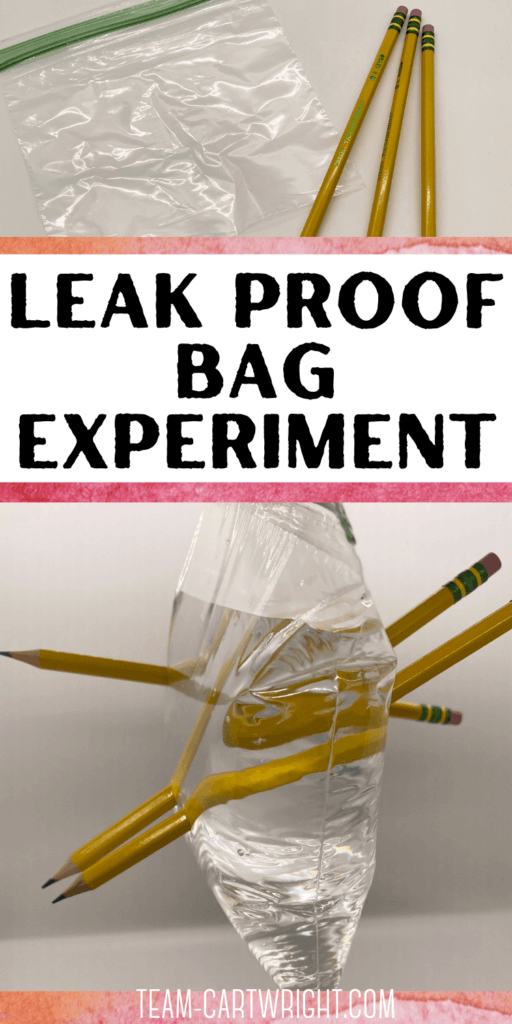
This activity is super fun to just experience, but it is also a great one to work through the scientific method with. Here are some tips to talk through it.
- Ask a Question: Ask your child, what do they think will happen when they stab the pencil into the bag of water?
- Observe: Look over the baggie and pencil. What does your child observe about them?
- Hypothesis: Let your child tell you what they think will happen when they put the pencil through the bag of water.
- Experiment: Time to stab the bag! Let them give the experiment a try and see what happens. Try more than once. What happens if they put the pencil in slowly compared to quickly?
- Data Analysis: Talk about what happened during the experiment. Did the water leak out? Or did it stay in the bag? Did they notice any patterns?
- Form a Conclusion: Ask your child to tell you the results of their experiment.
- Next Steps: We don’t have to stop at the conclusion. Ask your child what they would like to try next? Do they have any ideas to further the experiment?
This is one of those STEM activities that gets kids really excited about science. It’s simple but full of learning. And it is so much fun!
You have got to try this leak proof bag science experiment. Trust me.

Let’s find your next fun activity!
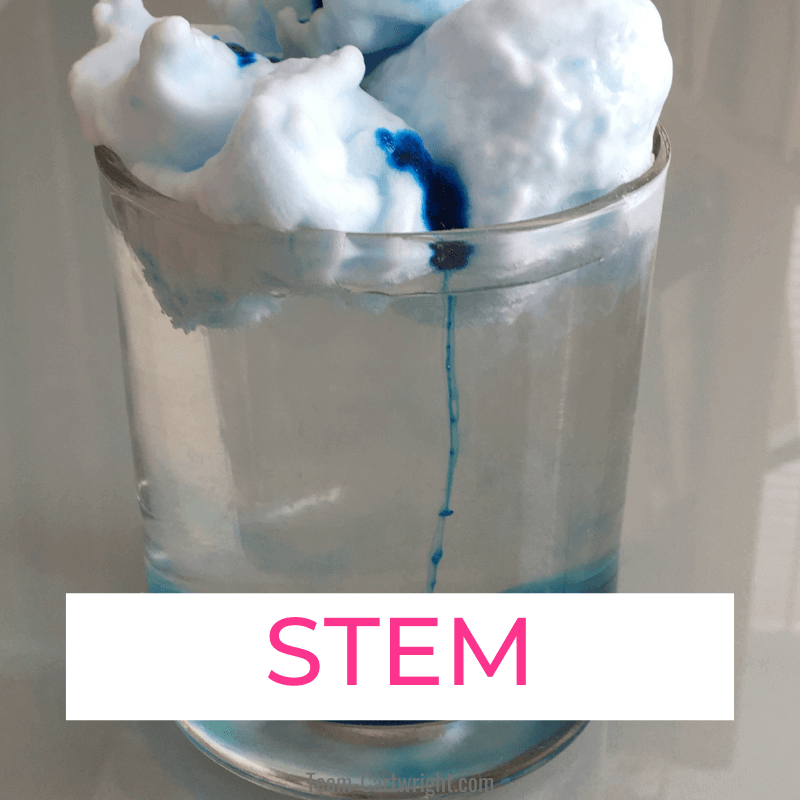
How to do the leak proof bag experiment! This simple science experiment wows kids and gives them an amazing chance to practice with the scientific method. Plus it is super fast and easy to do!
- Resealable plastic baggie
- Fill the baggie with water and seal.
- Take a sharpened pencil and push it through the bag. Leave it in place. The water won't come out!
This is a pretty safe activity, but as you are using sharpened pencils please use adult supervision. Remind your child not to aim the sharp point towards anyone's face or eyes.
Do this activity over a sink or a bowl of some sort. Once you remove the pencils the water will come streaming out of the bag.
To clean up remove the pencils from the bag and let the water drain out. Throw out the bag.
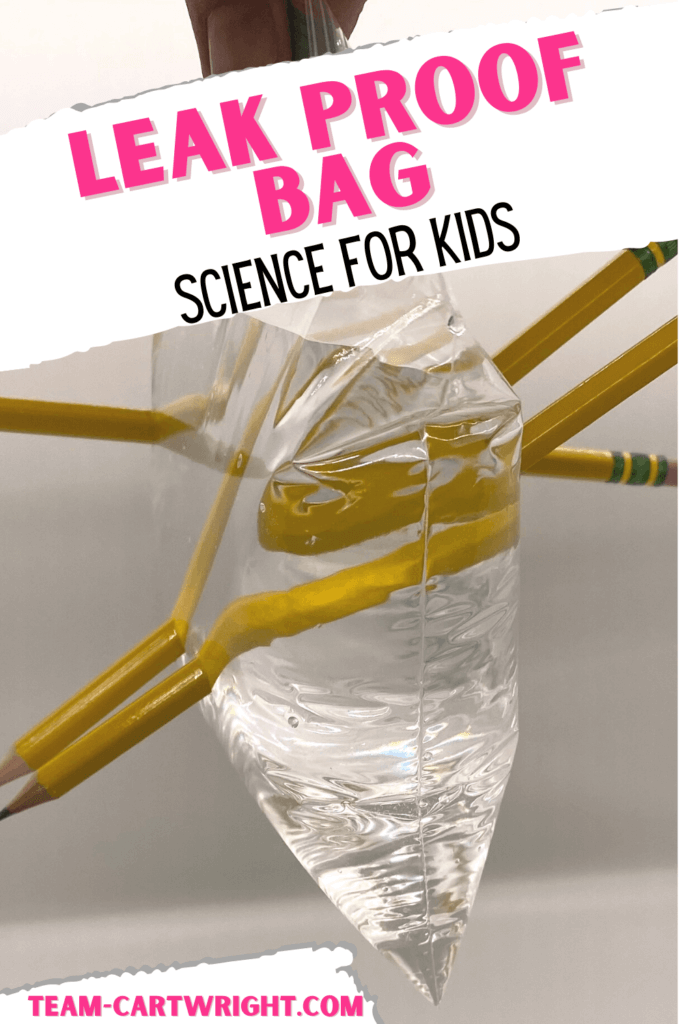
How useful was this post?
Click on a star to rate it!
Let us improve this post!
Tell us how we can improve this post?

* Checkbox GDPR is required
This site uses Akismet to reduce spam. Learn how your comment data is processed .
- Skip to primary navigation
- Skip to main content
- Skip to primary sidebar

- FREE Experiments
- Kitchen Science
- Climate Change
- Egg Experiments
- Fairy Tale Science
- Edible Science
- Human Health
- Inspirational Women
- Forces and Motion
- Science Fair Projects
- STEM Challenges
- Science Sparks Books
- Contact Science Sparks
- Science Resources for Home and School
Leak Proof Bag Experiment
May 2, 2019 By Emma Vanstone Leave a Comment
Here at Science Sparks we love a bit of science magic and this leak proof bag is one of the best. My daughter used this for a school talent show when she was just 5 and the rest of the class loved it!
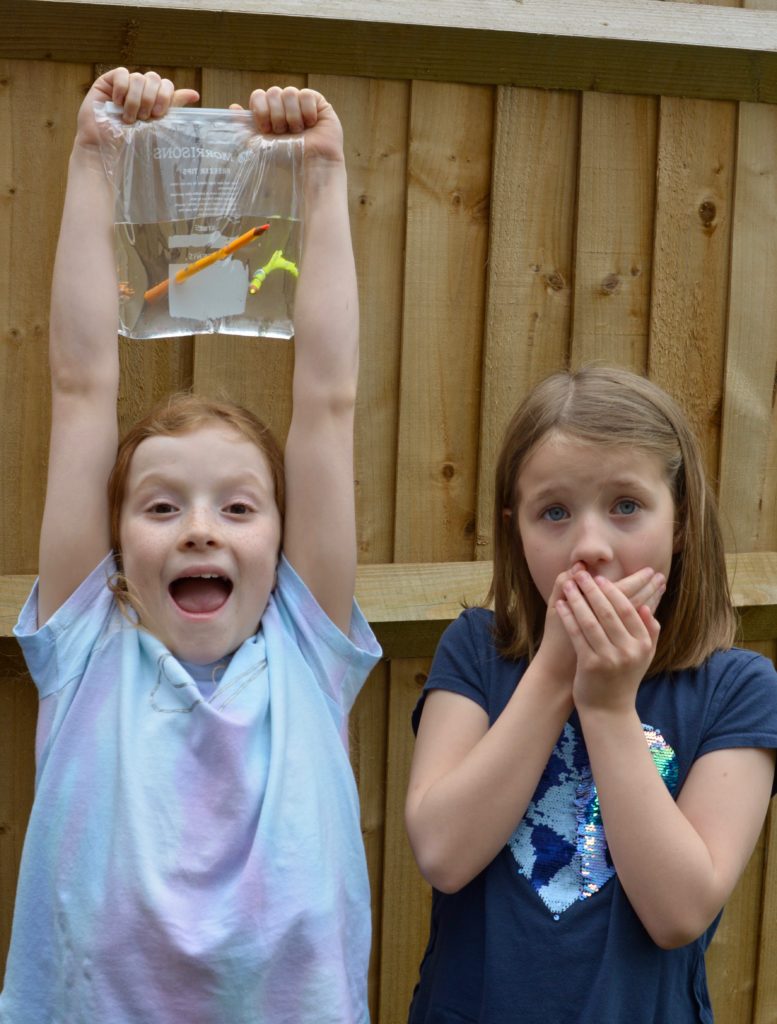
How to make a leak proof bag
Sharp pencils
Plastic sealable bag
We made our bag Halloween themed by adding bugs and bouncy eyeballs, but you don’t need to do that.
Instructions
Half fill the bag with water and seal it carefully.
You need to be brave for the next part. Make sure your pencil is sharp and push through the bag, you don’t need to be especially fast, slowly and carefully works well.
Once you’re done, show your audience your leak proof bag.
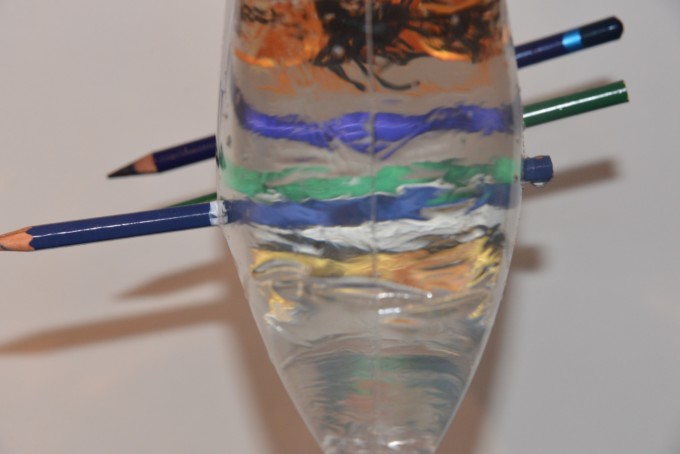
Why does the leak proof bag work?
This trick works because the plastic bag forms a temporary seal against the edge of the pencil. If you were to take the pencils out the bag would leak.
Extension Tasks
Does a blunt pencil work as well?
How many pencils can you push through the bag?
Does the thickness of the pencil make a difference?
More Cool Science Tricks
Make an egg float, a lemon sink, defy gravity and more with our fun selection of cool science tricks .
Did you know you can step through an index card without breaking it ?
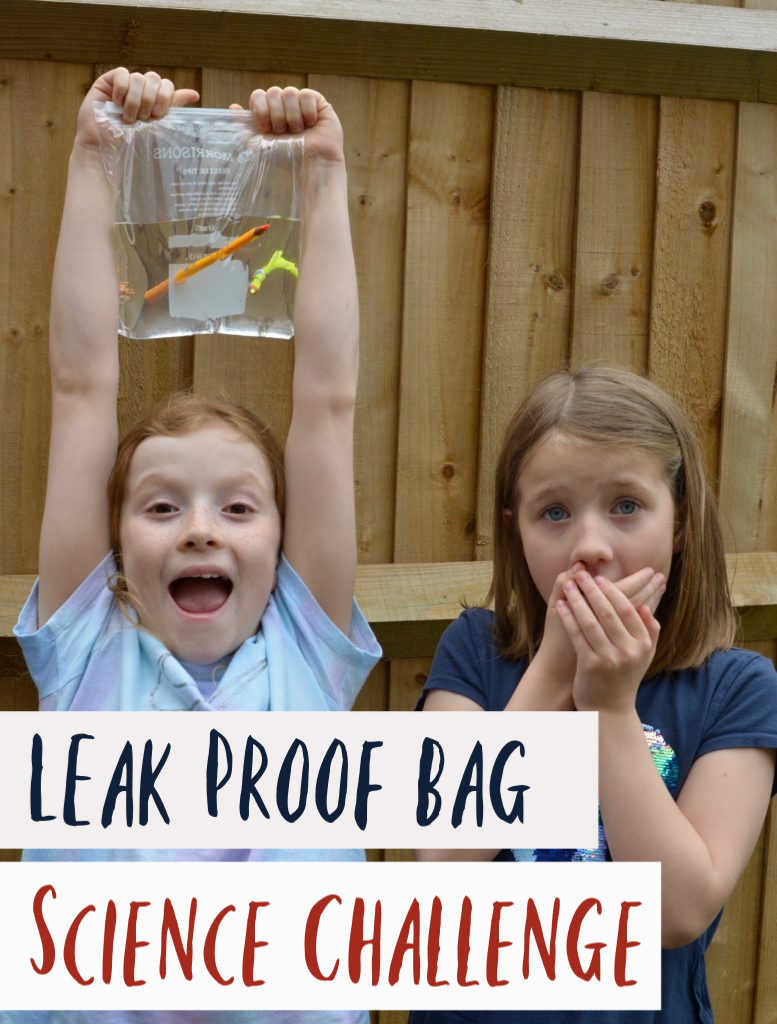
Last Updated on March 31, 2022 by Emma Vanstone
Safety Notice
Science Sparks ( Wild Sparks Enterprises Ltd ) are not liable for the actions of activity of any person who uses the information in this resource or in any of the suggested further resources. Science Sparks assume no liability with regard to injuries or damage to property that may occur as a result of using the information and carrying out the practical activities contained in this resource or in any of the suggested further resources.
These activities are designed to be carried out by children working with a parent, guardian or other appropriate adult. The adult involved is fully responsible for ensuring that the activities are carried out safely.
Reader Interactions
Leave a reply cancel reply.
Your email address will not be published. Required fields are marked *
- Skip to primary navigation
- Skip to main content
- Skip to primary sidebar
- MEMBER LOGIN
Hands On As We Grow®
Hands on kids activities for hands on moms. Focusing on kids activities perfect for toddlers and preschoolers.
The Leak-Proof Bag Experiment You Need to Try
Science Grade School Kindergartners Preschoolers Experiment 9 Comments
The leak-proof bag experiment is a fun science experiment in which your kids get to poke pencils right through a plastic baggy filled with water.
Amazingly, the water doesn’t come pouring out!
This is a quick and easy experiment to set up too.
Grab a sealable bag, any size will work. We used a quart sized baggy. Fill it up with water and close up tightly.
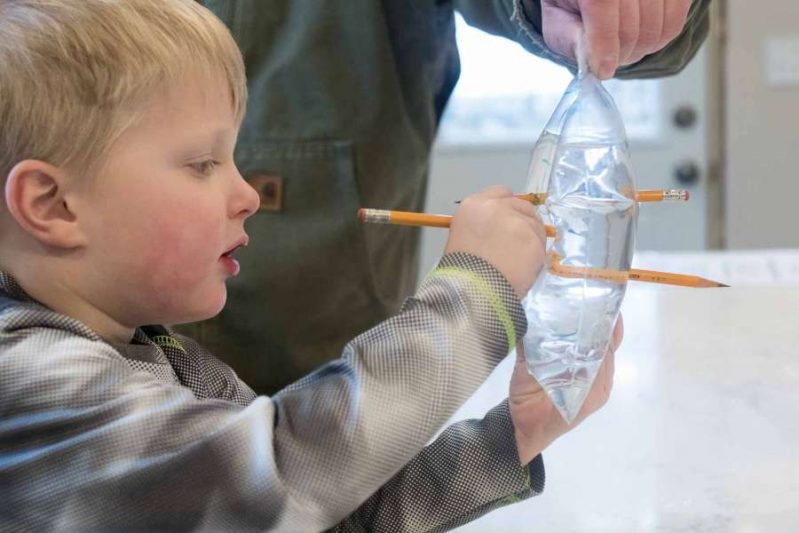
Then stick sharpened pencils through it!
Yep, that’s right it doesn’t leak!
I thought I was going to need super sharp pencils, but that wasn’t the case. The pencils went through with ease.
One person needs to hold the bag of water while your child pokes the pencils through.
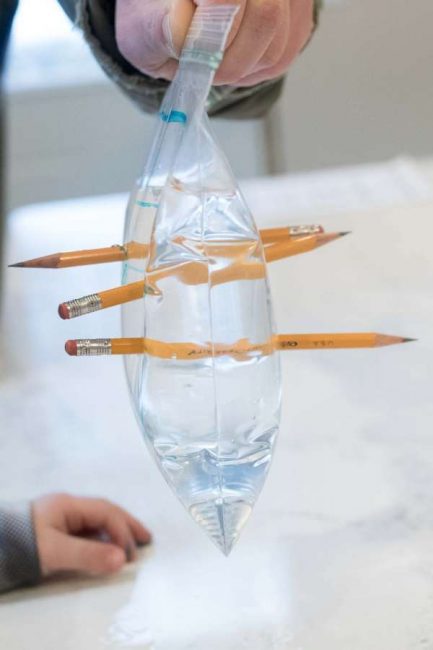
It’s pretty cool! And my kids were amazed! We did it over and over again.
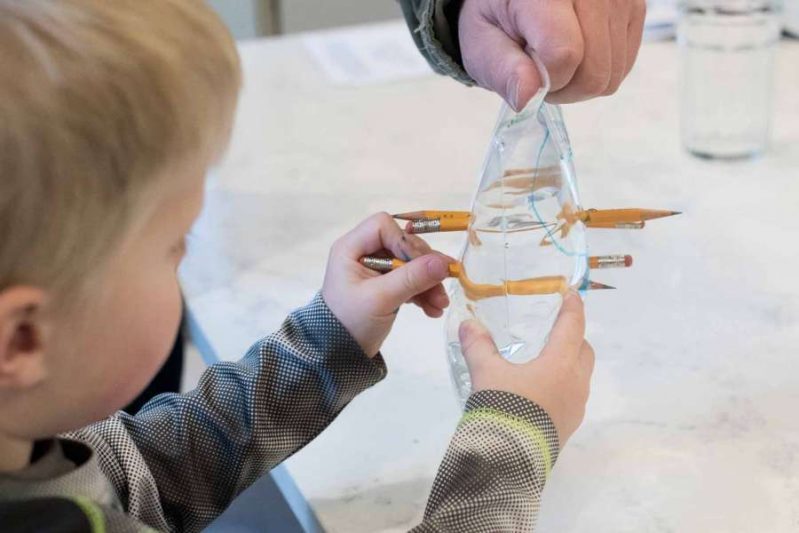
One side note, the bag will leak if you start poking a pencil through and remove it. If that’s the case, stick the pencil into the hole and continue through to the other side.
You’ll see in the video below we had a slight leak because of that.
The science behind the Leak-Proof Bag Experiment
This idea came from a science teacher, Curt Nelson of MakeAKidnection.com , who shared the experiment with the details of why the bag doesn’t leak.
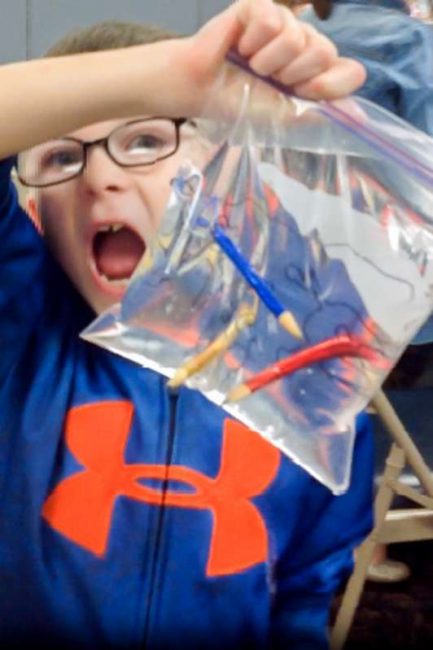
Leak-Proof Bag Experiment Supplies:
- A plastic baggy (I use quart-size, but sandwich size will also work)
- A few sharpened pencils to poke through the bag
- A permanent marker to draw faces on the bag
- Water to fill the bag about 2/3 full
Then prepare the bag as shown in the video below.
The Added Fun
To spice the experiment up, we’re going to pretend that germs have invaded our water supply. Your kids will come to the rescue and help us exterminate those pesky germs.
And to make sure your kids get into the spirit, Bob the Dragon and I shot a short video to set the stage.
Watch the middle portion of this video with your kids:
https://www.youtube.com/watch?v=sjQQ0jVVGKk
The Science Behind the Leak-Proof Bag
Why doesn’t the water leak out of the bag? It’s because plastic bags are made of polymers, or long chains of molecules. The pencil squeezes between two chains, increasing the gap between them at the point, but it doesn’t break the chains.
Watch this part of the video to see how many pencils I was able to poke through one bag — it’s really an amazing example of polymer science.
Extra-credit
Latex balloons are also made of polymers, which means you can poke a skewer right through a balloon without popping it (if you know the secret). If you want to blow your kids’ minds, follow this link to get my super-simple explanation of this fun magic trick / science demo . Your kids will love it!
More experiments like the leak-proof bag experiment:
- What Dissolves in Water?
- What Absorbs Water?
- Mix Colors Magically with Milk
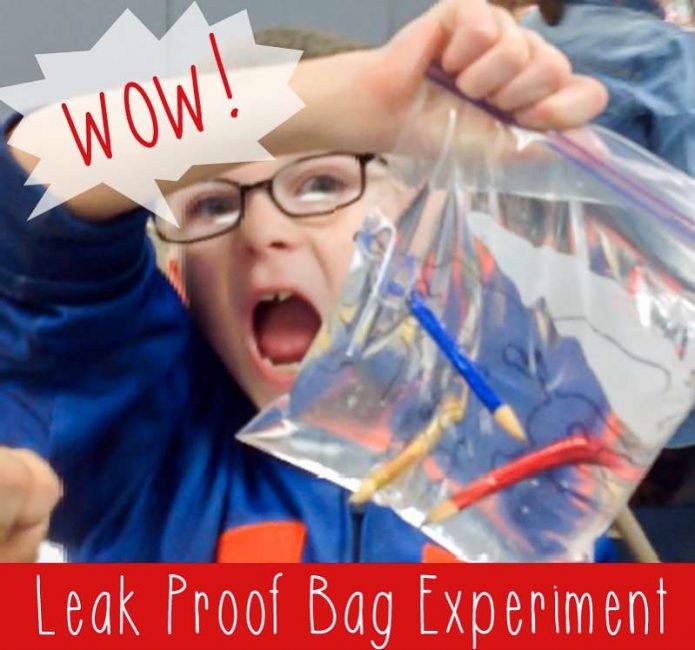
Curt Nelson is a former science teacher and school assembly presenter. Now he (and Bob the Dragon) use stories to make learning science fun at MakeAKidnection.com. Follow along with him on YouTube and Facebook.
About Guest
A guest contributor of hands on : as we grow. Please take a moment to show some love to our contributors by checking out their blog too! If you're interested making a contribution to hands on : as we grow, check out the guidelines and shoot me an email.
More Hands on Kids Activities to Try
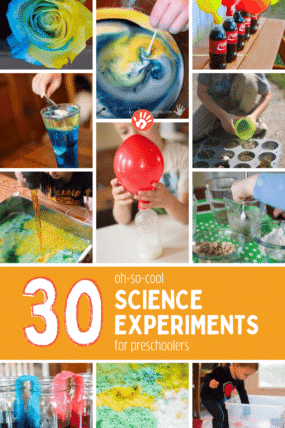
Reader Interactions
October 20, 2016 at 12:09 pm
I’ve tried this experiment with school age kids. For extra fun we did it on a hot day and had a volunteer stand under the bag while we poked the pencils in!
Curt Nelson says
March 23, 2015 at 12:06 pm
Hi Jamie! Thanks for letting me share this science experiment with your readers! I love all the great activities on your site!
Leave a Comment Cancel reply
Your email address will not be published. Required fields are marked *
This site uses Akismet to reduce spam. Learn how your comment data is processed .

What Parents Have to Say…
Shop ebooks of activities.

Get activity plans delivered to your inbox, every week!
Activities that hands-on parents absolutely love.
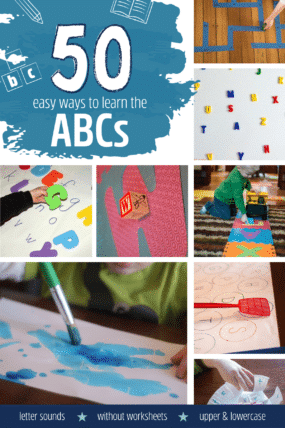
50 Simple & Fun Alphabet Activities for Preschoolers
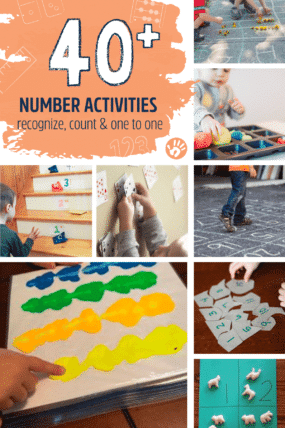
40+ Awesome Number Activities for Preschoolers

Make a Color Sorting Sensory Bag with Your Kids: Super Easy & Squishy

How to Make a Lava Lamp Experiment Without Alka Seltzer

Why Routines for Kids are Important

35 Name Activities For Preschoolers
Get started having fun with your kids.
PLAN THE FUN WITH THE FREE KIDS ACTIVITIES PLANNER! AND RECEIVE ACTIVITIES EVERY WEEK!

- Preschoolers
- Kindergartners
- Grade School
- Literacy & ABCs
- Math & 123s
- Art Projects
- Gross Motor
- Shop Activity Plans
- Member Login
- Skip to main content
- Skip to primary sidebar
Engage your learners in a unique experience with our Codes and Ciphers Fun Pack! Click here
- Homeschooling
- Member Log In
- Search this website
Gift of Curiosity
Sparking children's creativity and learning
The leak proof bag: A kid-friendly science lesson about polymers
Kindergarten , 1st Grade , 2nd Grade , 3rd Grade , 4th Grade , 5th Grade
Sharing is caring - thank you for spreading the word!
This post may contain affiliate ads at no cost to you. See my disclosures for more information.
So one day recently I filled a plastic bag with water. Then I handed my kids some sharpened pencils and asked them to poke holes in the bag.
They looked at me like I was crazy.
I can’t say I blame them. Even I wasn’t entirely sure my plan was going to work. There was always the possibility that we would have all ended up soaking wet.
But fortunately, science won out and we stayed dry, even after punching a number of holes in the bag.
And that was how I started our lesson about polymers. 🙂
Note: Find more science experiments on my Science Activities for Kids page!
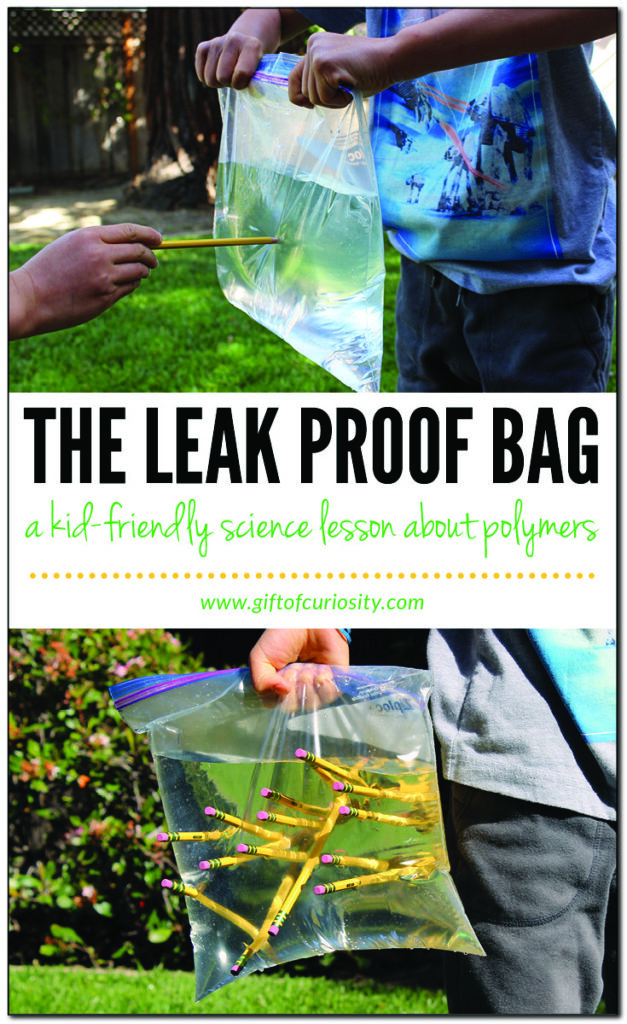
The Leak Proof Bag
The leak proof bag is a high interest activity to introduce your children to polymers, specifically a polymer called low-density polyethylene (LDPE).
And if you don’t care to get into the nitty gritty of the science, it just makes for a really fun experience.
To do this activity, you will need to gather the following materials:
- a plastic bag (we started with a gallon size Ziplock brand bags )
- pencils with rounded sides (rather than flat sides)
- pencil sharpener
Begin by ensuring all of your pencils are very sharp.

Then fill your plastic bag at least half full with water.

Ask your child to poke a hole in the bag with a pencil. Tell them to poke the pencil through both sides of the bag, but not to poke the pencil all the way through.
(If you are worried about spillage, consider doing this part of the activity outdoors or over a sink.)
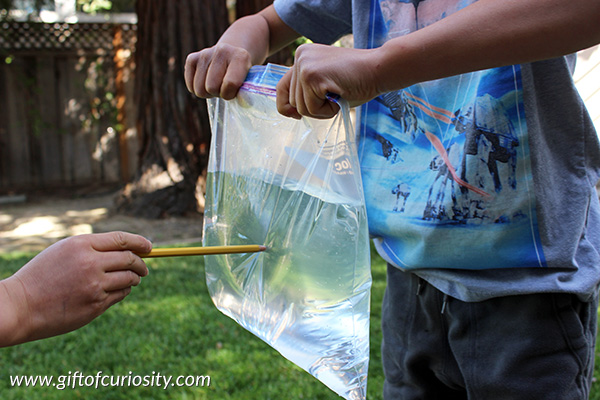
If your children feel so inclined, have them continue to stick pencils into the bag.
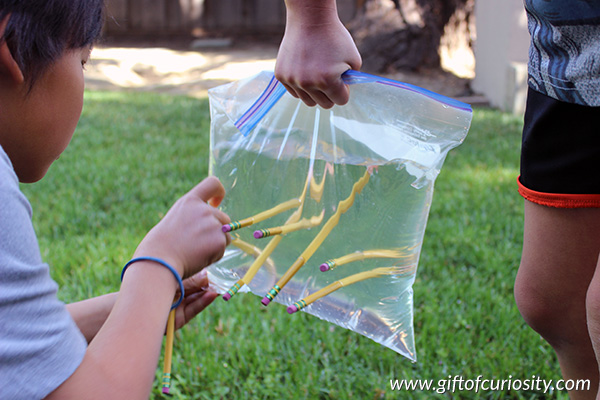
We ended up with more than a dozen pencils in our bag.
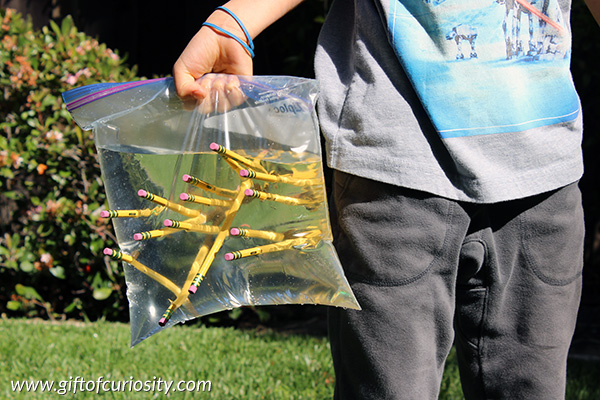
And despite all the holes, there were no leaks!
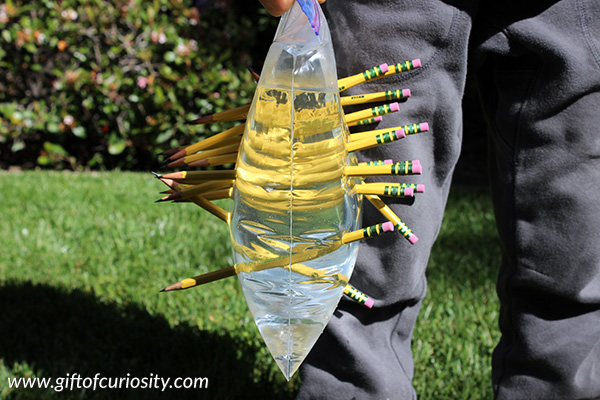
We talked about polymers and how they create a seal around the pencils, effectively closing off any holes in the bag.
We decided to see if other types of plastic bags would do the same thing. So we grabbed a plastic bag I picked up from the bulk food aisle of our grocery store.
This bag was made of a thinner material than the first bag we used, but it was still relatively sturdy.
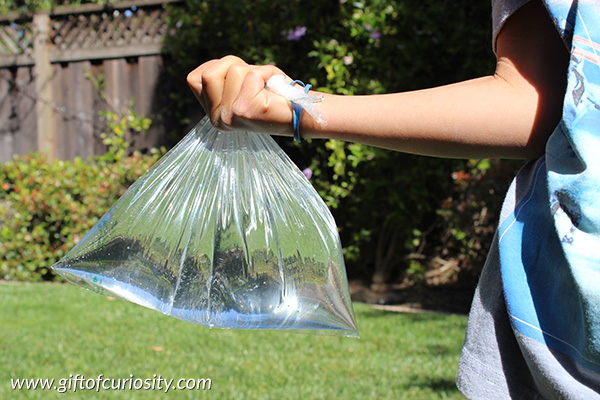
We stuck some pencils in, feeling some trepidation as to whether the bag would leak or not.
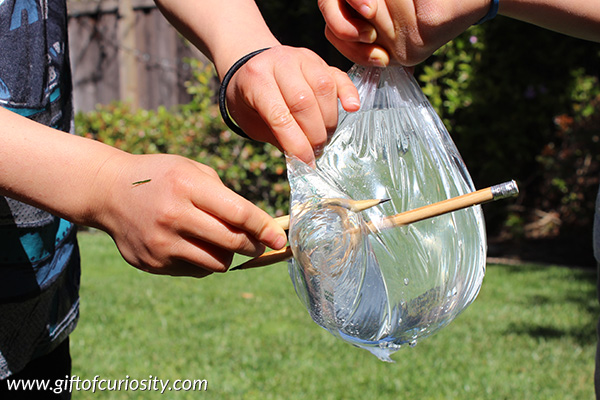
But this bag was also leak proof.
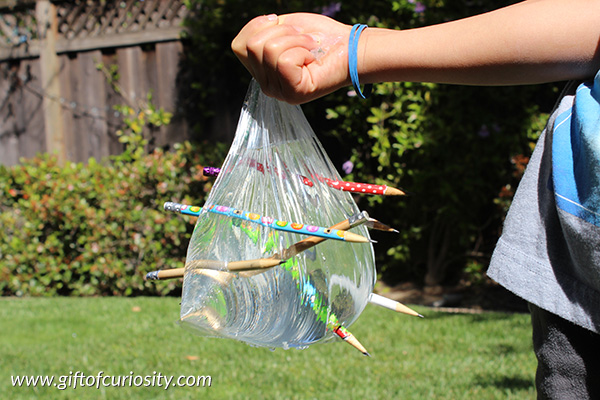
So we decided to try with another plastic bag. This time we used a thin, cheap plastic bag from the produce section of the grocery store.
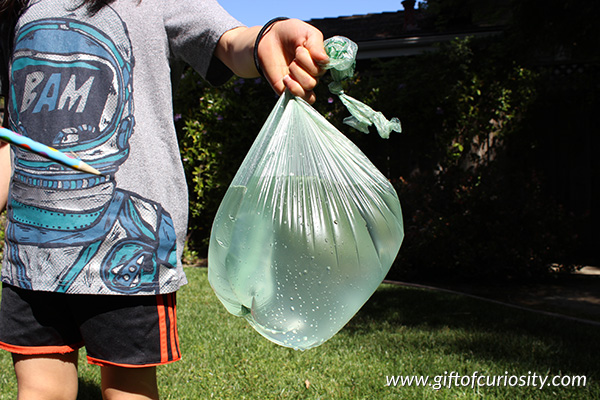
We stuck some pencils in and the bag quickly began to leak.
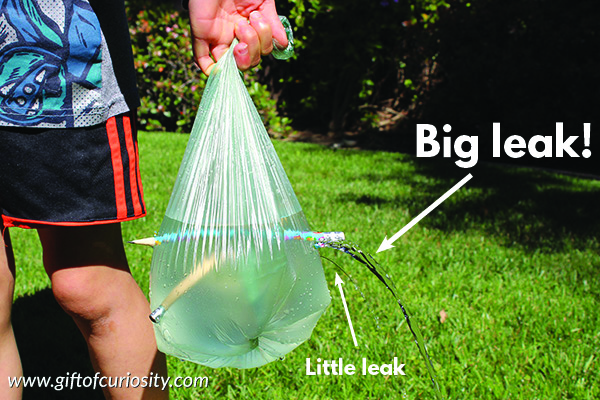
The holes did not seal up around the pencils but gaped and allowed water to escape.
We were glad we did this part of the experiment outdoors!
The Science Behind the Activity
What is a polymer.
A polymer is a chemical compound that has molecules bonded together in repeating chains. The term polymer is often used to describe plastics.
Polymers have unique properties that can be tailored for different uses.
For example, useful properties of polymers include being lightweight but strong, being non-conductive in terms of heat or electricity, resistance to corrosion, transparency, and low cost.
Low-density polyethylene
One common type of polymer is polyethylene , which is made of chains of ethylene (C2H4) molecules. Polyethylene comes in various forms, one of which is low-density polyethylene (LDPE).
LDPE is one of the most widely produced plastics in the world. LDPE is a very flexible material with high ductility (the amount it can deform before rupturing) but low tensile strength (the amount of stretching it can endure before breaking).
LDPE’s unique properties, including its low cost, light weight, durability, flexibility, and the fact that it is waterproof make it highly valued as a packaging material. Indeed, many plastic bags, such as the zip top bag used in this activity, are made of LDPE.
How LDPE creates a leak proof bag
Polyethylene molecules are flexible but weak. Therefore, they separate easily to make a hole where the pencil is poked in, but they flexibly seal around the pencil to prevent the water from leaking out.
When the pencil is removed, the hole in the bag remains and the water leaks out.
It is easier for the polyethylene molecules to seal around the edges of a rounded pencil than a pencil with flat sides. So if your bag leaked, check that you used rounded pencils. Also, make sure the pencils go in straight so the hole they create is the same diameter as the pencil.
More science activities for kids
More science posts from Gift of Curiosity:
- Dancing raisins
- DIY glitter bouncy balls
- Candy experiments
- Jumping colors science activity
- Make your own glycerin soap
- Make your own telescope
- Magic inflating balloons
Find more great science activities on my Science Activities for Kids page and my Science Activities Pinterest board.
You May Also Enjoy These Posts
Reader interactions.
May 20, 2021 at 6:28 am
I tried this not thinking it would work with sandwhich bag but amazingly it did
May 20, 2021 at 7:34 am

Leak Proof Bag Science Experiment for Kids
This leak proof bag science experiment is sure to WOW your kids! All you need is two household supplies and you can do this water experiment with your kids too.
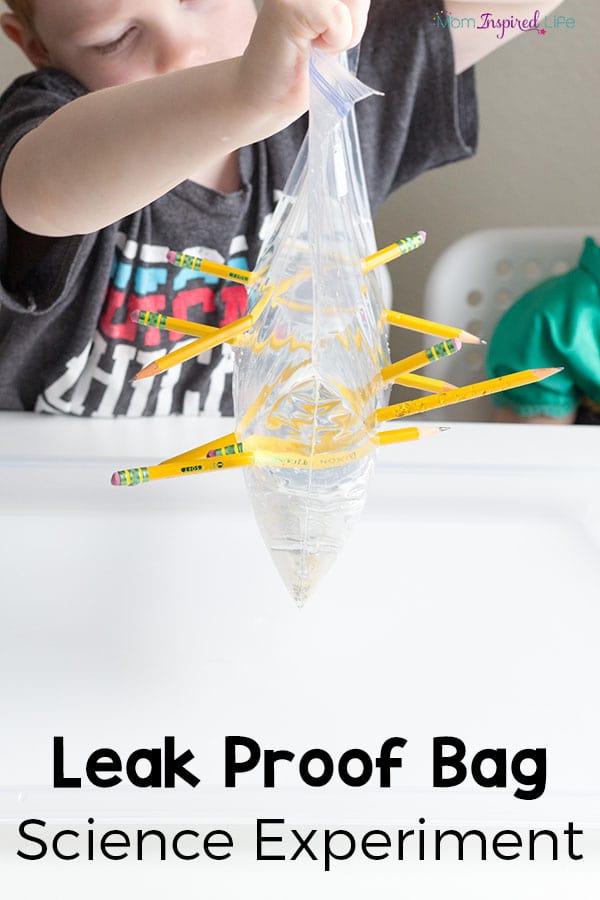
This post contains affiliate links.
Lately, the kids and I have been doing lots of neat science experiments. They both love them and even ask if we can do another science experiment all the time. Some of our favorites have been this lava lamp experiment and this cloud in a jar experiment .
*Note: This science experiment should be done with adult supervision at all times.
If your kids are into science experiments too, stay tuned to the blog because we have lots more planned. But for now, check out these super cool leak-proof bag experiment!
Leak Proof Bag Science Experiment
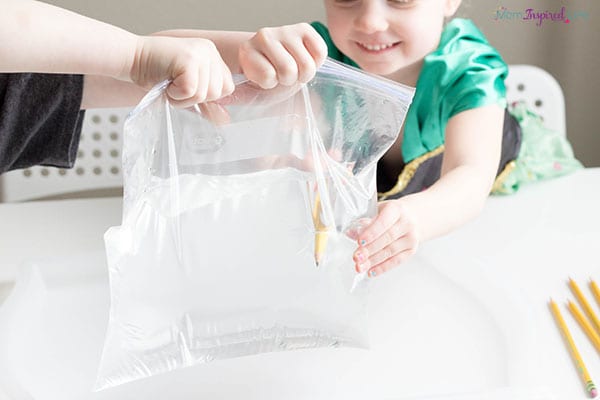
To begin, fill a gallon size storage bag about half full with water. Then poke a pencil straight through the bag – in one side and out the other.
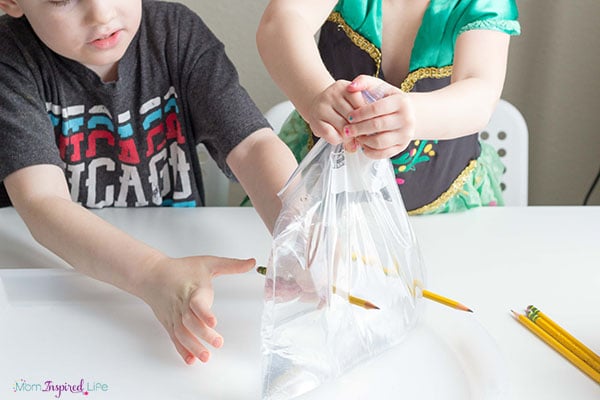
Much to everyone’s surprise, the bag won’t leak! This is because the bag is made of a polymer – which is long, flexible chains of molecules. When you poke the pencil through the bag, the molecules spread apart and then seal themselves around the pencil. It’s really cool!
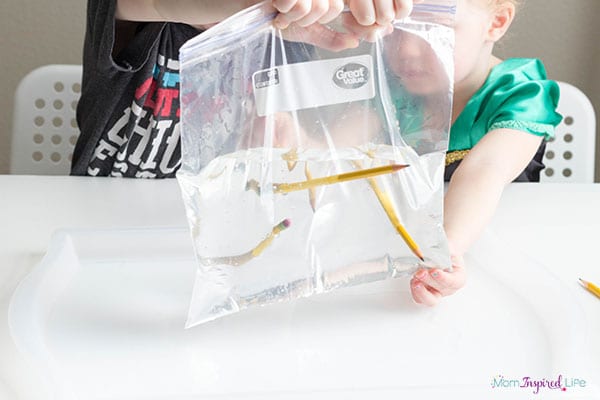
My kids would do this for a long time if we had enough pencils. They just think it’s so cool that they can poke the pencils through the bag and it won’t leak.
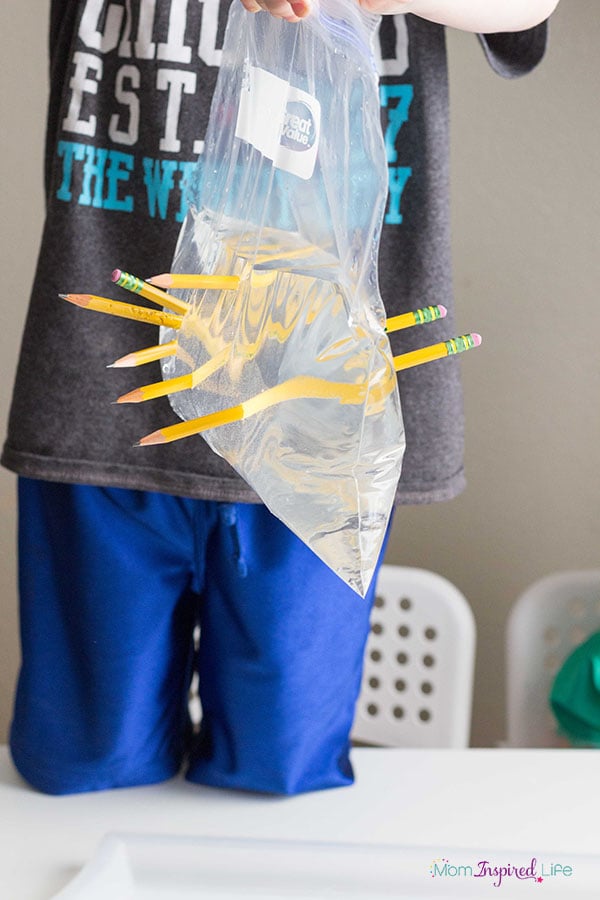
If you are wondering what age this experiment is for, I will say that my 3.5 year old was able to do it no problem and as you can see she really enjoyed it. As always, supervision is required though.
Supplies Needed:
As an Amazon Associate I earn from qualifying purchases.
- Gallon size storage bag
- Sharpened pencils
- Fill a gallon size storage bag about half full with water.
- Poke a pencil straight through the bag – in one side and out the other.
That’s all! Do this over and over again for lots of amazement.
If you do this with your kids email and let me know. I bet they will love it!
Check out these other cool science experiments!
30 Science Activities for Preschoolers That are Totally Awesome
Growing Plants Science Activity
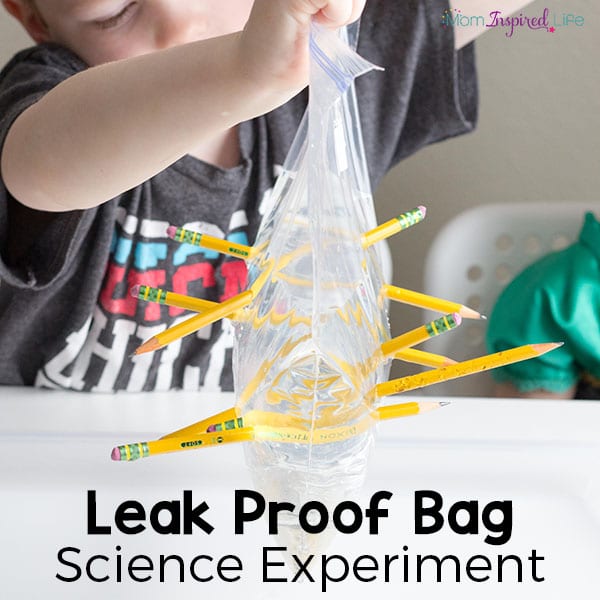
- JOIN COURSES
Leak-Proof Bag STEM Experiment

Leak-Proof Bag Pencil Arrows is a fun kids science experiment for preschoolers and kindergarteners to explore STEM education and properties of a polymer.
Can you poke a hole in a bag of water and prevent the water from coming out? Well, after learning the science behind this pencil arrows experiment, you will be ready to poke holes in a bag full of water while holding it over someone’s head! Besides, this Leak-Proof Bag STEM Experiment will take you less than five minutes to set using items around the house. Most importantly, your child will witness how a polymer reacts to holes being pressed through it without having to go to a science lab!

WHAT you will need for this Leak-Proof Bag STEM Experiment:
- a zip-lock bag
- sharpened pencils
HOW to conduct this Pencil Arrows STEM Experiment:
First, fill the zip-lock bag about 2/3 full of water. Next, squeeze out the air, and zip it closed. Thereafter, hold the bag up and, using the sharp end of one pencil, carefully poke the pencil through the bag until it pierces both sides, but not all the way. Make sure though that the pencil goes in on one side and comes out the other side. Ask your child, how much water would leak out?

Observe: The pencil went in one side and out the other without spilling a drop!
Science mystery behind this Leak-Proof Bag STEM Experiment:
Most plastic bags are made from low-density polyethylene. Polyethylene is a plastic polymer which is durable, long, flexible chains of molecules. So, when you poke a pencil through the bag into the polymer, the pencil slides between the molecules. Those molecules stretch and spread apart, thereafter sealing themselves around the pencil as they return to their original unstretched position. Thus, the polyethylene molecules separate but do not break! As such, the tip of the pencil squeezes between the chains and chains’ flexible property helps to form a temporary seal against the edge of the pencil. This seal prevents the water from leaking through the holes!

Do this activity outside or over a sink or a waterproof tray as the water will pour out when the pencil is removed or pushed all the way! Also, if the pencil is pierced into the bag before the water is put in, the water will leak! Because polymers cannot seal themselves back together, due to the large opening, the water will pour out and the bag will leak! Find more cool experiment in a book The 101 Coolest Simple Science Experiments .
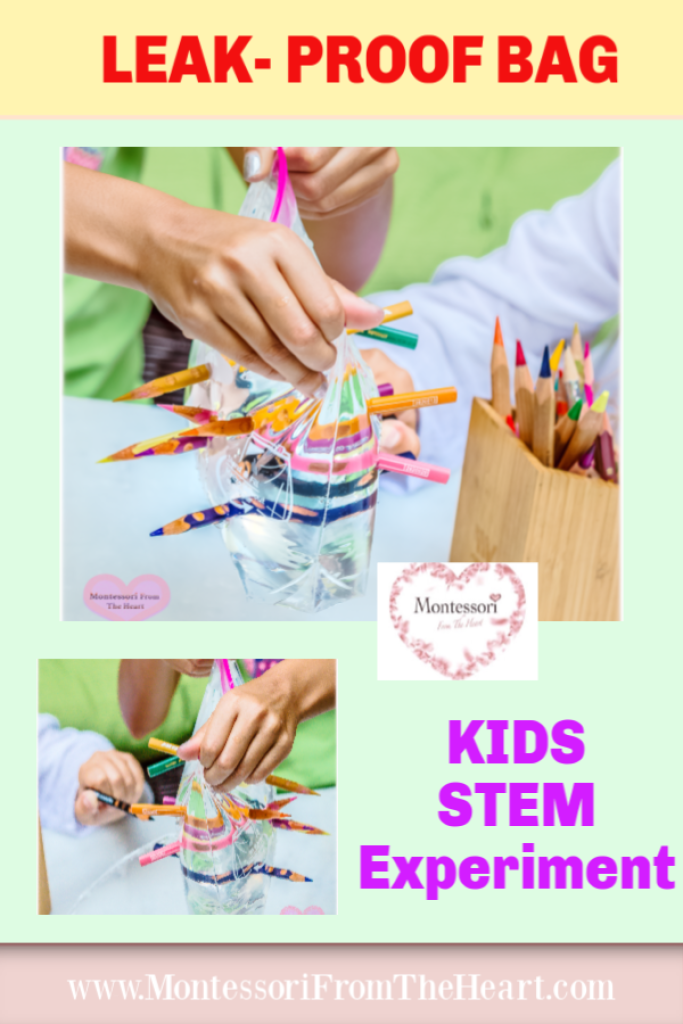
Try this STEM experiment with a faceted pencil, a larger pencil, or a thicker pencil. What happens?
For more STEM experiments, see HERE Magic Milk Experiment. Also, see HERE Magic Balloon Experiment your kids would love!
Please, always supervise your children.
♡ Enriching the Mind one Heart at a time ♡
For more ideas, find us on Instagram , Facebook , and Pinterest .
- Click to share on Pinterest (Opens in new window)
- Click to share on Facebook (Opens in new window)
- Click to email a link to a friend (Opens in new window)
- Click to share on Twitter (Opens in new window)
POSTS YOU MIGHT LIKE
You might also like.

Beaded Pipe-Cleaner Indian Corn

Thanksgiving Turkey Color-Match DIY

Leaves Size-Sorting Kids Activity
[…] you liked this STEM Kids Science Experiment, see HERE Leak-Proof Bag experiment. Also, see HERE Dancing Corn-Raisin trick. Lastly, see HERE Fizzing […]
CHAT WITH ANYA Cancel reply
Copyright 2024 © Montessori From The Heart ♡ All Rights Reserved Disclaimer
As a participant in the Amazon Services LLC Associates Program and LTK, I earn affiliate commission from qualifying purchases.
Please enable JavaScript in your browser to view the content
SEARCH MY BLOG
Discover more from montessori from the heart.
Subscribe now to keep reading and get access to the full archive.
Type your email…
Continue reading
- About Natacha
- Natacha’s Blog
- Resources for parents
- Activities for children
- Books + Toys
Leak-Proof Bag Experiment
This is one of my favourite experiments. I chose it because it is a great S.T.E.M. game and it is also one we can all do at home, since all you need is a plastic Ziploc bag, a few pencils and some water. It is so fun to watch the children’s reaction when they pierce the bag with the pencil, expecting all the water inside to come pouring out, and instead finding that not a drop spills out! How can that happen, you ask? Polymer chains work together to prevent water from leaking out of the bag.
Best Ages for This Activity
This activity is great for three to five-year-old children (or older).
How to Make It
Ingredients
- A few pencils – three or four are fine, but you can do more if you wish, or you can try with just one if that is all you have.
- A pencil sharpener
- A medium Ziploc bag or use any containers with tight lids you have around the house
- Uncooked pasta noodles of any shape and size
- Packets of Kool-Aid
Let’s Get Started!
- Find a workspace where children expect a giant mess (outside on the grass, or above the kitchen sink, or in your bathtub)
- Sharpen your pencils very well (of course, this is something your child can do). Make sure all the pencils are sharpened to a point or it won’t work.
- Fill the bag with water and seal it closed (1/2 the bag should be full of water when closed. No need to fill to the top).
- Invite your child to form a hypothesis by saying: “I wonder what will happen if we pierce the bag with this pencil” – you can write down their hypothesis (for example, the water will pour out of the bag, or whatever they think will happen)
- Here comes the fun part: while you (or your child) hold the bag up by the top, your child can slowly pierce a pencil through one side of the bag and halfway out the other side (like in the picture). You can ask “What happened?”
- Much to your child’s amazement, you will see that the pencil can go right through without leaking a drop of water!
- What actually happened, though? How is it possible? The long chains of molecules that make up the bag (they are called polymer chains) actually seal back around the pencil and prevent water from leaking out. Magical! – see below for a more elaborate explanation.
- Now try putting another pencil through, and another! You can put lots of pencils through.
Learning Opportunities
Children will learn S.T.E.M. while trying this science experiment. Questions you can ask your child during the experiment are:
- How is it possible for the water to stay in the bag after we pierced the bag with a pencil?
- Why is the water not leaking out?
- What happens if we take the pencil out? (save this one for last as this will be the end of your experiment – bye-bye water)
Here is what actually makes this possible:
The Ziploc bag you used, like many plastic bags, was most likely made out of a polymer called low-density polyethylene, which is very flexible. When you push a (sharp) pencil through, these long, flexible polymer chains (strands) get pushed apart by the pencil, but don’t break. Instead, they re-seal around the pencil.
By doing this experiment mostly on their own, children can form many hypothesis of what will happen, why it will happen, what will happen next, etc. This is how they learn science . As they are following all the steps, they are learning sequencing, which is great for reading as well as math .
CEFA tip: Remember to let your child do as much of the process as they are capable of.
Things to Keep in Mind
- Make sure you are doing this experiment outside or over a sink, as the water may spill! Also keep in mind that the pencils are sharp, and your child needs to be supervised.
Extended Learning Opportunities
Try with different types of bags (for example, grocery bags, or very thick produce bags) and follow the same scientific process:
Now try different types of pencils (some are perfectly round while some have edges). Which pencil works best?
Books Your Child Might Like
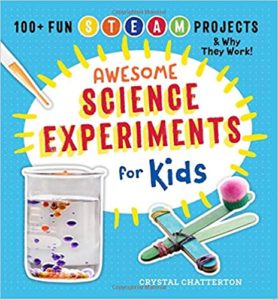
Cool Science Experiments Headquarters
Making Science Fun, Easy to Teach and Exciting to Learn!
Science Experiments
Why Doesn’t the Water Leak?
Would you believe me if I told you that we can poke holes in a bag full of water without water leaking out? Probably not, but that’s exactly what happens in this fun science experiment!
Prepare to be amazed, watch our demonstration video, then grab a plastic bag and a pencil to try it yourself! Printable instructions and a simple explanation of how the experiment works are included.
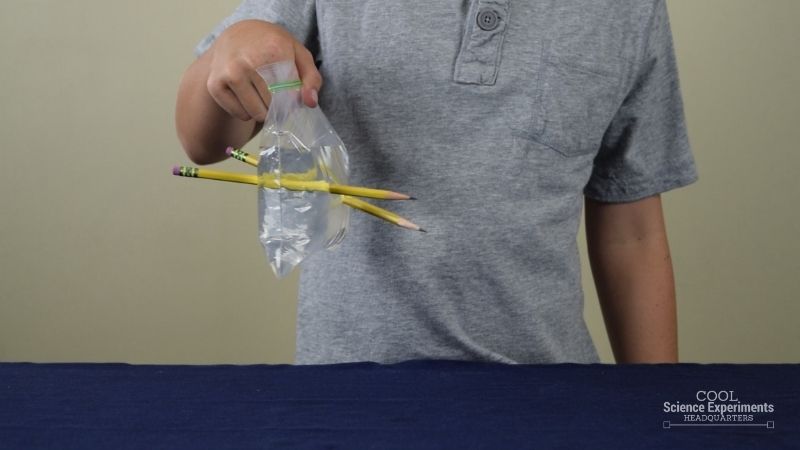
JUMP TO SECTION: Instructions | Video Tutorial | How it Works | Purchase Lab Kit
Supplies Needed
- Plastic Baggie
- Sharpened Pencils

Why Doesn’t the Water Leak Science Lab Kit – Only $5

Use our easy Why Doesn’t the Water Leak Science Lab Kit to grab your students’ attention without the stress of planning!
It’s everything you need to make science easy for teachers and fun for students — using inexpensive materials you probably already have in your storage closet!
Why Doesn’t the Water Leak Science Experiment Instructions

Step 1 – Fill a plastic baggie a little more than 1/2 way full of water.
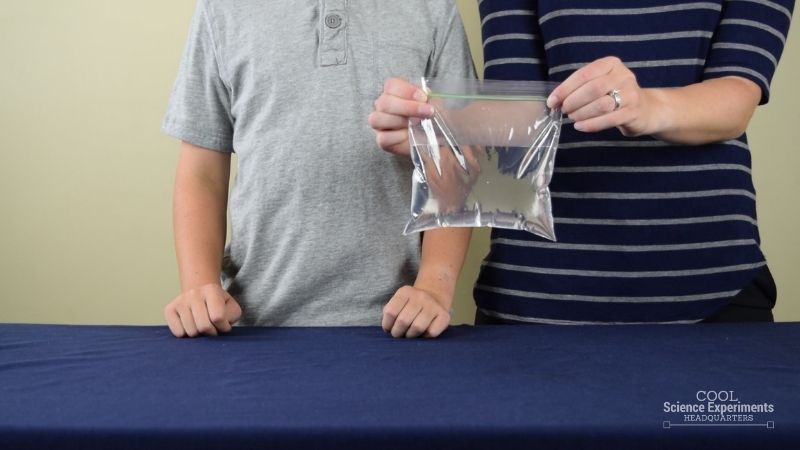
Step 2 – Seal the baggie. What do you think will happen if you poke the baggie with a pencil? Do you think it will create a hole in the baggie? If so, what do you think will happen next?

Step 3 – Quickly stab a sharpened pencil through the baggie. Make some observations about what happened. Did the pencil poke a hole in the bag? What happened to the water? Did you expect the water to leak out of the hole? Is the water leaking out? Write down your observations.
Step 4 – Try stabbing multiple pencils through the baggie. Are you surprised at what happened? Do you know the why the water didn’t leak out? Find out the answer in the how does this experiment work section below.
Video Tutorial
How Does the Science Experiment Work
The magic of this experiment lies in polymers. Polymers are long chains of molecules that make up many items we use in our everyday lives – specifically plastic items. Zipper top plastic baggies (like the one used in our experiment), plastic grocery bags, plastic water, and soda bottles, and plastic food packaging are all made of polymers. Products made of polymers are flexible, lightweight, leak-proof, and low in cost to produce.
Think of polymers as long chains of beads. When you stab a pencil through the bag, the polymers move apart. This is the same as if you stuck a pencil between two chains of beads. Because polymers are flexible, when you stab a pencil through the bag, the polymers push back toward the pencil and form a temporary seal. This prevents the water from leaking out of the holes. If you remove the pencils from the bag, the holes will remain in the bag because you have permanently pushed the polymers aside, allowing water to leak out.
I hope you enjoyed the experiment. Here are some printable instructions:

Why Doesn’t the Water Leak Science Experiment
Instructions.
- Fill a plastic baggie a little over 1/2 way full of water.
- Seal the baggie.
- Quickly stab a sharpened pencil through the baggie.
- Try stabbing multiple pencils through the baggie.
- Why doesn’t the water leak?

Reader Interactions
February 5, 2017 at 9:26 am
cool this looks like a fun project
December 18, 2017 at 6:55 pm
this is really COOL!!!!!!!!!
March 1, 2019 at 1:54 pm
This is so cool and i love it
May 6, 2019 at 2:56 pm
Very interesting my children are enjoyed too much when they experiment at home
December 7, 2019 at 11:18 pm
I am doing that for myself for my sience fair
January 4, 2020 at 4:44 am
Leave a Reply Cancel reply
Your email address will not be published. Required fields are marked *
Save my name, email, and website in this browser for the next time I comment.

- Privacy Policy
- Disclosure Policy
Copyright © 2024 · Cool Science Experiments HQ
- Skip to main content
- Skip to primary sidebar

Leak Proof Bag Science Experiment
I knew this leak proof bag science experiment with the kids was a project that would have a high fun factor since the kids LOVE anything that includes water play . Since it is such a simple science project it was the perfect addition to our DIY summer science camp with Coffee Cups and Crayons .
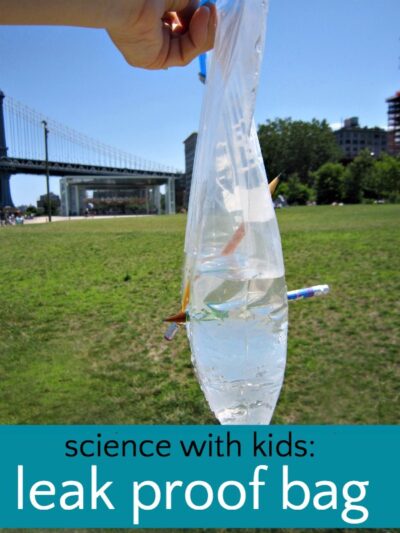
I wanted to do the experiment outdoors and as long time readers ( give yourselves a round of applause ) know, we live in an apartment so I packed up the supplies as we headed out for a day at the park. It made a nice break when the kids started whining about going home and bought me some more time away from the apartment.
What you need:
- Sealable plastic bags
- Sharp pencils
- Bored or enthusiastic children
Instructions:
1. Fill the bags with water. When we got to the park we found this awesome drinking fountain station set up! ( Sorry about bad photo, I accidentally had my camera set to 1600 ISO! ) We did get a few curious looks when we filled our bags, but never mind!
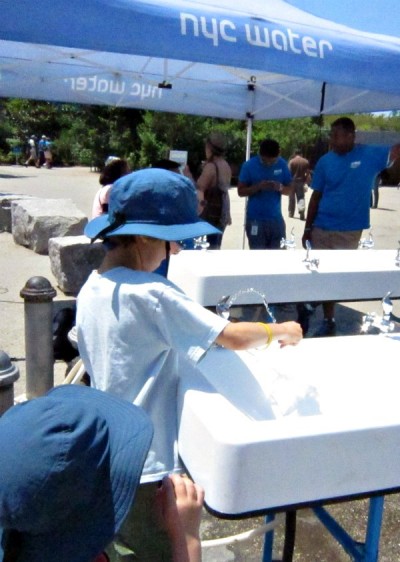
2. Close bags.
3. Poke pencils through bags. My 9 year old lay the bag flat, but it works better if you are holding the water-filled bag upright.
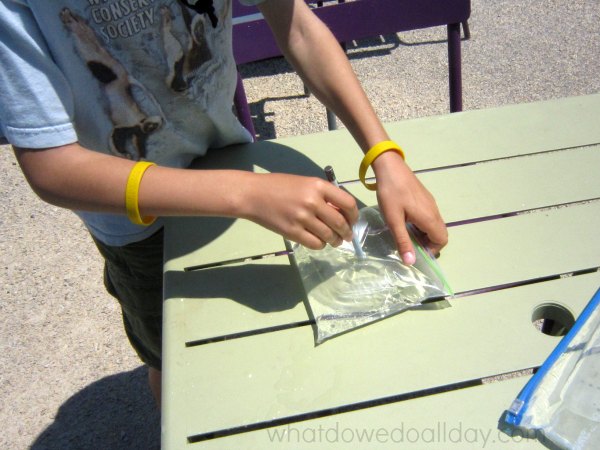
Be sure not to push the pencils all the way through the bags. The tip needs to be poking out one side, and the eraser needs to be sticking out the other side ( see top photo ). However, if you pull the pencil completely out the other side, the bag will leak. Obviously.
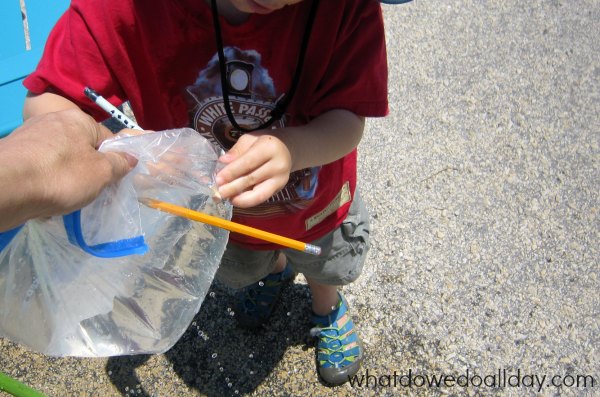
There was a lot of free play with this science experiment because naturally, water is always a draw for my kids.
The science behind it:
Steve Spangler explains the leak proof bag science experiment works because plastic bags are made from polymers. Poking the pencils through the bag only separates the molecule chains, it doesn't break them. My 9 year old is only starting to understand the concept of molecules, so this was a great starting point for him. Of course, my 5 year old was more interested in what happened when you pulled the pencil out!
What was my 5 year old's favorite part?
He could create his very own personal drinking fountain.
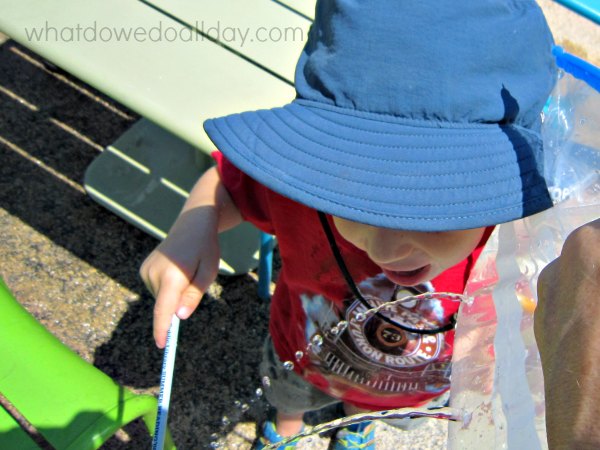
Summer Science Camp so far:
On this blog: Ice cube on a string , Solar oven , Homemade compass , Balloon rocket race
At Coffee Cups and Crayons: Mentos geyser , Dancing raisins , Liquid layers , Homemade silly putty
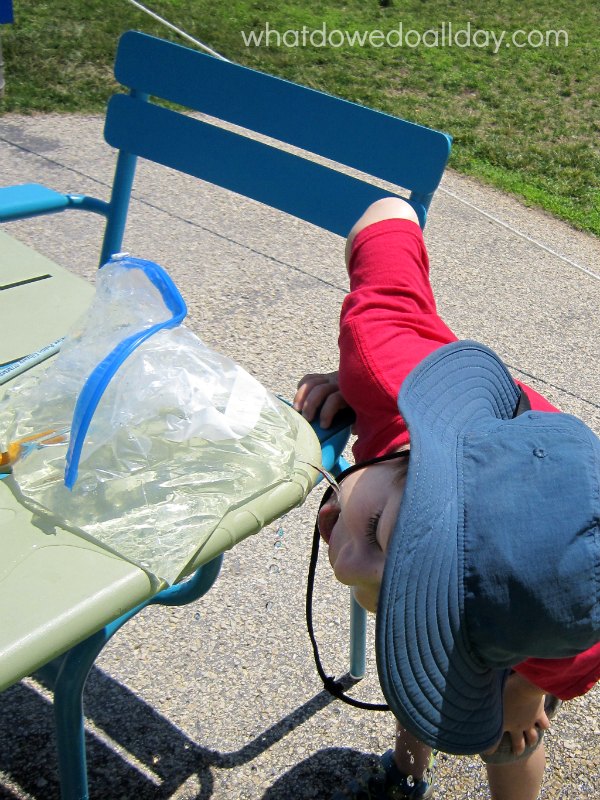
What science projects are you doing this summer?

Reader Interactions
July 24, 2014 at 11:48 am
Neat! My kids love playing with water too. I think I will put these supplies in my bag to try at the pool today, not the "bored or enthusiastic children" they won't fit 😉
Erica MomandKiddo says
July 24, 2014 at 1:13 pm
Almost Unschoolers says
July 24, 2014 at 6:27 pm
Another classic we need to try again!
MaryAnne says
July 30, 2014 at 1:11 am
Yep, this is on my to try list as well...
studyathomemama says
August 09, 2014 at 5:03 pm
All I can picture is my daughter going and attacking all of the plastic bags in the fridge that I use to store/defrost/marinate meat... She already uses pens to open things more than scissors (something she may or may not have witnessed from me...)
August 10, 2014 at 7:44 am
Yeah, that might not be so good! 🙂
Leave a Reply Cancel reply
Your email address will not be published. Required fields are marked *
This site uses Akismet to reduce spam. Learn how your comment data is processed .
Get Your ALL ACCESS Shop Pass here →

Leakproof Bag Experiment
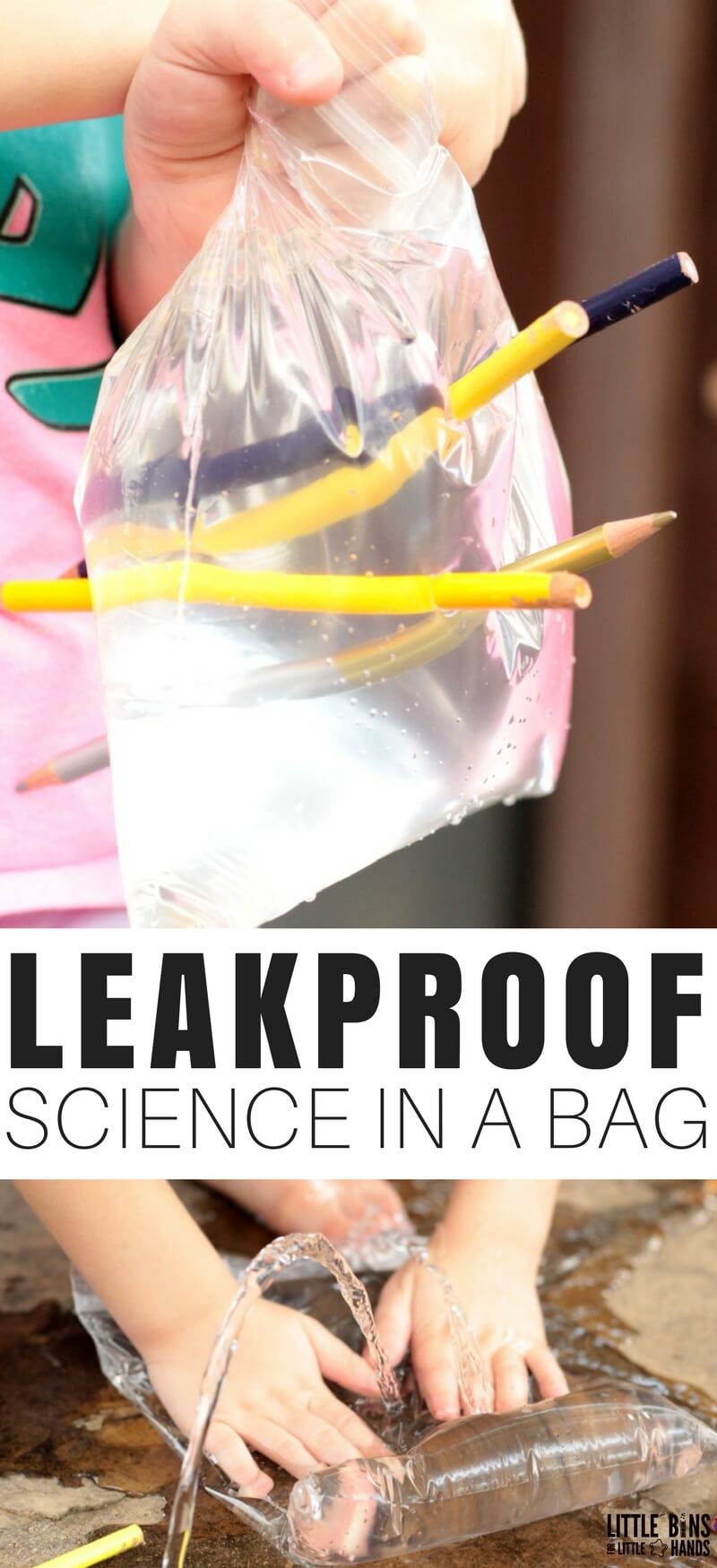
Sometimes science can appear a bit magical, don’t you think! I bet you have seen or heard of the pencil in a bag water trick. Well, now you can do it for yourself! Find out why you can put a pencil through a bag of water with this easy-to-set-up leakproof bag experiment . Can you pull it off without getting soaked? Did we? We love easy and fun science experiments for kids !
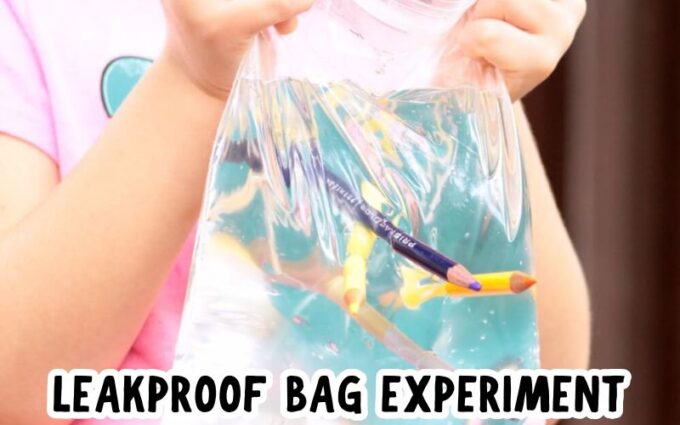
This particular science project involves a bit of mystery and that’s exactly why kids will have a blast trying it out, testing it, and figuring out what’s going on?
- Sharpened Pencils
- Zip Top Plastic Gallon Bag
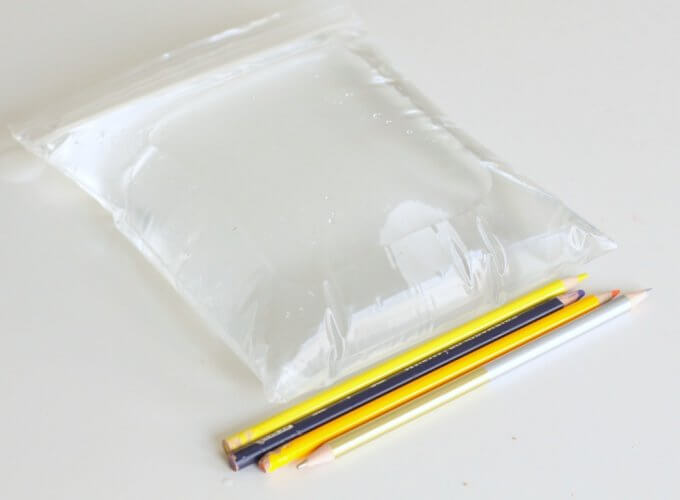
Instructions:
TIP: Just note that this activity might be best for a warm day outside! If not, make sure you are over a sink or tub and have some towels handy.
STEP 1. Make sure to start with freshly sharpened pencils if you can!
STEP 2. Fill your plastic bag with water and seal tightly.
STEP 3. Now for the fun part! Take a sharpened pencil and poke it through the bag! Don’t hesitate or you may find it will leak a bit.
STEP 4. Try it again! How many pencils can you put through the bag? Make a guess and see what happens!
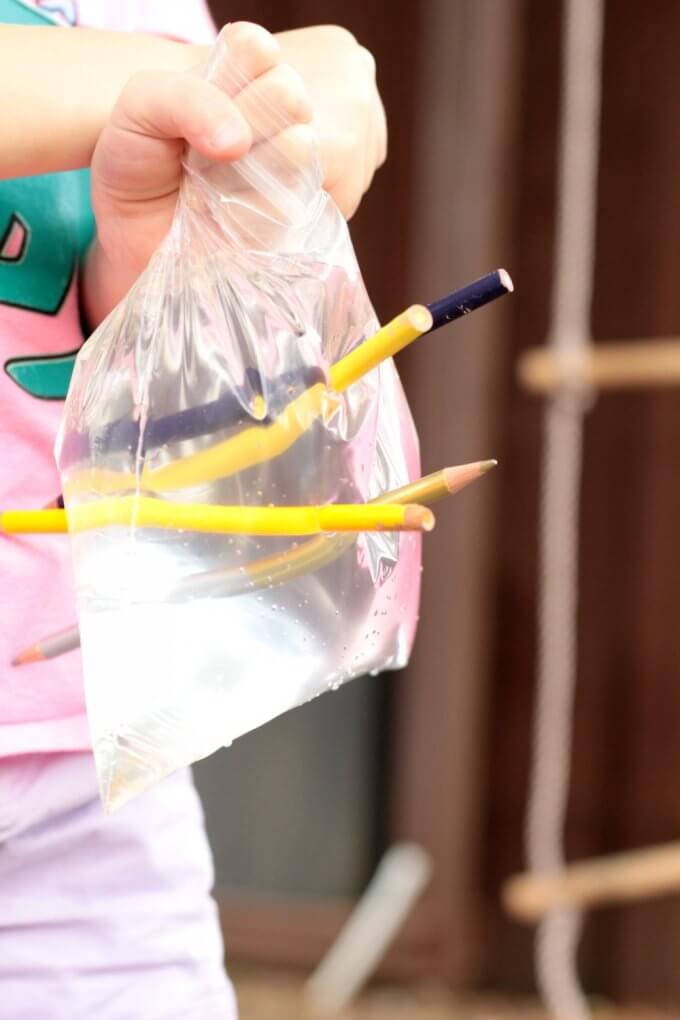
How Does It Work?
You would think that water would leave the bag when you stab it with pencils. This leakproof bag science experiment may look a lot like magic, but it’s also cool chemistry! What’s going on between the water, the plastic bag, and the sharpened pencils?
You can put a pencil through a bag of water because the plastic bag is made up of polymers which are long strands or chains of molecules. When the sharpened pencil pushes through the plastic bag, it’s actually pushing through the polymer chains.
The chains or strands are pushed aside by the pointy pencil but then re-seal themselves around the pencil preventing water from leaking out. See what happens when you try to push a dull or unsharpened pencil through!
LOOK: 65 Amazing Chemistry Experiments for Kids
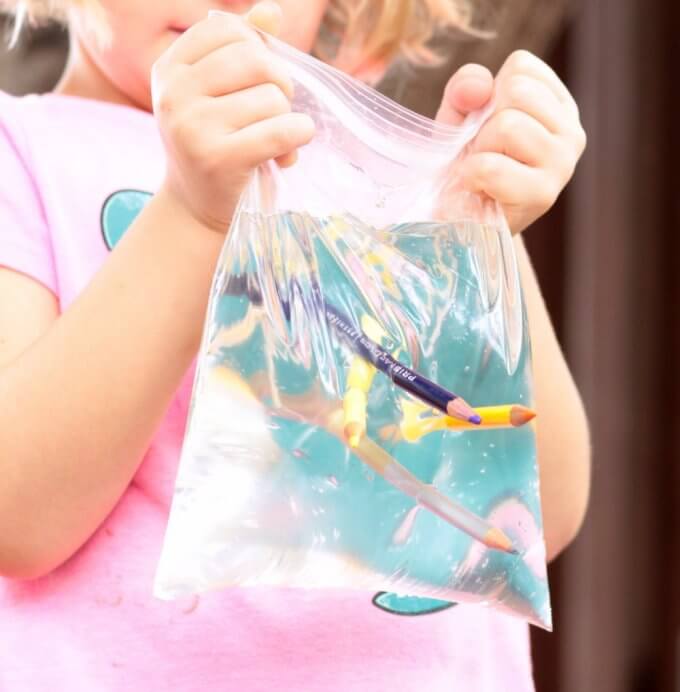
Now of course when you remove the pencils the holes will be left and the water will definitely leak out, everywhere. Also, make sure not to push the pencils all the way through or you will have holes and leaks too.
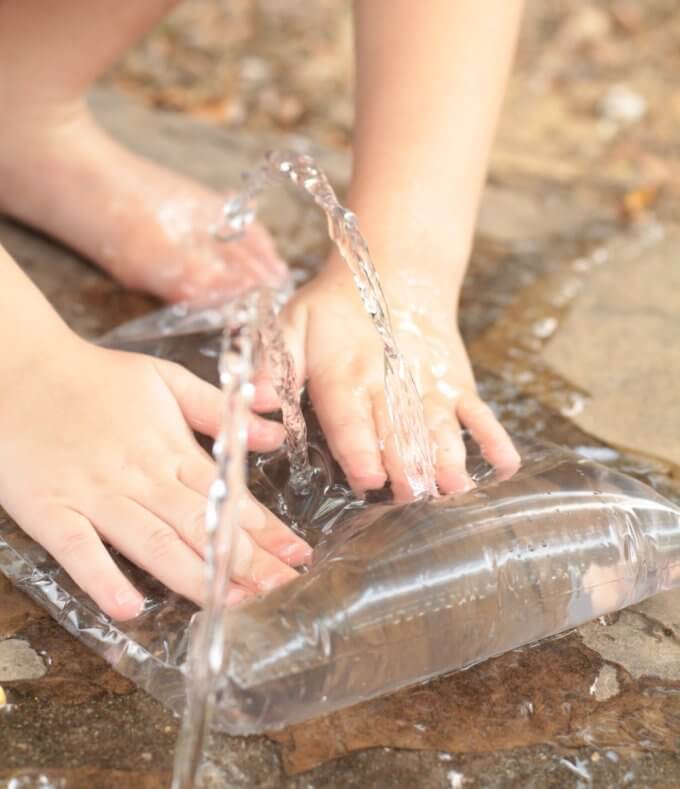
Get Your Printable Science Experiment Worksheets

Turn It Into A Science Project
Science projects are an excellent tool for older kiddos to show what they know about science! Plus, they can be used in all sorts of environments including classrooms, homeschool, and groups.
Kids can take everything they have learned about using the scientific method , stating a hypothesis, choosing variables , making observations and analyzing and presenting data.
Want to turn one of these experiments into an awesome science fair project? Check out these helpful resources.
- Science Project Tips From A Teacher
- Science Fair Board Ideas
- Easy Science Fair Projects
Helpful Science Resources To Get You Started
Here are a few resources that will help you introduce science more effectively to your kiddos or students and feel confident yourself when presenting materials. You’ll find helpful free printables throughout.
- Best Science Practices (as it relates to the scientific method)
- Science Vocabulary
- 8 Science Books for Kids
- All About Scientists
- Free Science Worksheets
- Science Supplies List
- Science Tools for Kids
More Fun Water Experiments To Try
There are so many fun experiments you can do with water! Check out our collection of preschool water experiments and water experiments for older kiddos !
Here are a few ideas you will love…
- What dissolves in water
- Walking water
- Saltwater density
- Rainbow In J jar
- How Many Drops On A Penny
- What Materials Absorb Water?

Printable Science Projects For Kids
If you’re looking to grab all of our printable science projects in one convenient place plus exclusive worksheets and bonuses like a STEAM Project pack, our Science Project Pack is what you need! Over 300+ Pages!
- 90+ classic science activities with journal pages, supply lists, set up and process, and science information. NEW! Activity-specific observation pages!
- Best science practices posters and our original science method process folders for extra alternatives!
- Be a Collector activities pack introduces kids to the world of making collections through the eyes of a scientist. What will they collect first?
- Know the Words Science vocabulary pack includes flashcards, crosswords, and word searches that illuminate keywords in the experiments!
- My science journal writing prompts explore what it means to be a scientist!!
- Bonus STEAM Project Pack: Art meets science with doable projects!
- Bonus Quick Grab Packs for Biology, Earth Science, Chemistry, and Physics

Subscribe to receive a free 5-Day STEM Challenge Guide
~ projects to try now ~.

Choose an Account to Log In

Notifications
Leak-proof bag experiment.

This is a surprising science experiment that your child will surely be awestruck by! It involves poking sharpened pencils into a bag filled with water without spilling a drop. Geared toward preschoolers and kindergarteners, kids of all ages will feel like magicians as they poke pencils through the bag with no water leaking out. This Leak-Proof Bag experiment introduces children to the cool chemistry behind polymers—long chains of molecules that are flexible—the reason there are no spills!
What You Need:
- A large sealable bag
- Sharpened pencils
What You Do:
- Show your child the baggy. Have them help you fill the bag with water, about ⅔ full.
- Ask your child, "What do you think might happen if you poke a pencil all the way through both sides of the baggy? Could you make a prediction?" Tell them that you are going to try to do this with a sharpened pencil to see if their prediction was right or not.
- Poke a pencil all the way through the baggy and have your child state out loud what they observed.
- Help your child poke more pencils through the bag to see what happens. See how many pencils you can get into the bag.
- Try different sized bags and different types of pencils to see if the leak-proof bag always works. Note: If you pull a pencil out, the bag will leak, so make sure to poke it all the way through and do not remove it until you are ready to have water everywhere.
The science behind this experiment has to do with the type of plastic that the baggy is made of. It is a stretchy type of plastic made up of polymer chains. When the pencil pierces the bag, the molecules in the polymer chain surround the pencil, sealing it up. And that's why you don't get any leaks! Of course, after your experiment, head outside to remove the pencils and have fun watering plants or playing with the water as it leaks through the holes.
Related learning resources
Add to collection, create new collection, new collection, new collection>, sign up to start collecting.
Bookmark this to easily find it later. Then send your curated collection to your children, or put together your own custom lesson plan.
- Leak-Proof Bag
- After School Activities
Share This Activity

Demonstrate how polymer chains work together to prevent water from leaking out of a plastic bag. Plastic bags are made out of polymers, which are long chains of individual molecules, called monomers. When the plastic bag is punctured with a sharpened pencil, the polymer chains are separated without being broken.
- Sharpened pencils
- Zipper-lock plastic bags
- Paper towels
Instructions:
- Make sure the pencils are sharpened to a point.
- Fill a zipper-lock bag between ½ and ¾-full with water.
- Gather hypotheses. What would happen if you pushed a sharpened pencil through the water-filled bag?
- Holding the bag in one hand, use the other hand to slowly, but firmly, push one of the sharpened pencils through one side of the bag. Make observations.
- Repeat with the other sharpened pencils.
- Once finished, hold the bag over a sink to remove the pencils.
Source: http://www.stevespanglerscience.com/lab/experiments/leak-proof-bag/
Lorem ipsum Quis aliquip aute in culpa est laboris anim irure proident tempor enim ut Lorem ipsum Quis aliquip aute in culpa est laboris anim irure proident tempor enim ut Lorem ipsum Quis aliquip aute in culpa est laboris anim irure proident tempor enim ut
Lorem ipsum Quis aliquip aute in culpa est laboris anim irure proident tempor enim ut exercitation in id occaecat dolor cupidatat cillum in velit tempor cupidatat aute et proident quis ex Duis. Lorem ipsum Quis aliquip aute in culpa est laboris anim irure proident tempor enim ut exercitation in id occaecat dolor cupidatat cillum in velit tempor cupidatat aute et proident quis ex Duis. Lorem ipsum Quis aliquip aute in culpa est laboris anim irure proident tempor enim ut exercitation in id occaecat dolor cupidatat cillum in velit tempor cupidatat aute et proident quis ex Duis. Lorem ipsum Quis aliquip aute in culpa est laboris anim irure proident tempor enim ut exercitation in id occaecat dolor cupidatat cillum in velit tempor cupidatat aute et proident quis ex Duis.
Lorem ipsum Quis aliquip aute in culpa est laboris anim irure proident tempor enim ut exercitation in id occaecat dolor cupidatat cillum in velit tempor cupidatat aute et proident quis ex Duis. Lorem ipsum Quis aliquip aute in culpa est laboris anim irure proident tempor enim ut exercitation in id occaecat dolor cupidatat cillum in velit tempor cupidatat aute et proident quis ex Duis.
Recommended Products

Related Activities
Sunscreen experiment for kids.
Teach students about the importance of wearing sunscreen! This science experiment for kids demonstrates how sunscreen counteracts, or blocks, the effects of the sun’s ultraviolet (UV) rays.

Tensile Bubbles
With tensile bubbles, students will observe how tensile structures are formed as the bubble solution is stretched both between the rigid edges of the wand and the joints that form…

Ice Pop Insulator
Try this science experiment for kids to explore insulation.
- Login | Register
Have 10% off on us on your first purchase - Use code NOW10
Free shipping for orders over $100
Available for dispatch within 2 days
Free gift with purchase of over $100
Check out with Paypal and Afterpay
Leak Proof Bag
Follow FizzicsEd 150 Science Experiments:
What you need
- One Zip Lock bag
- Water (enough to fill up the Zip Lock bag)
- Five Sharp pencils
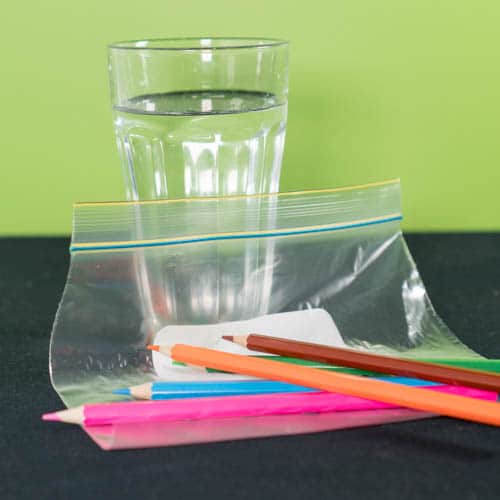
- Instruction
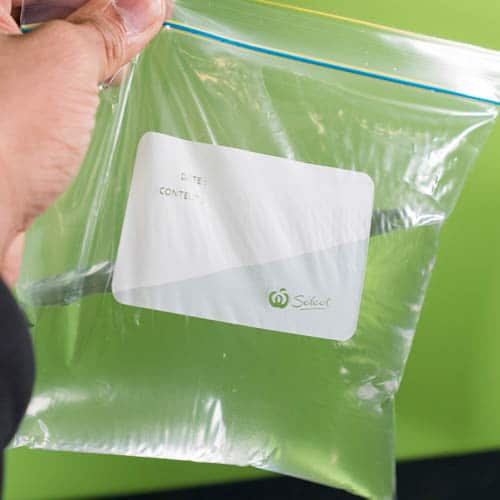
Fill the ziplock bag with water and close it.
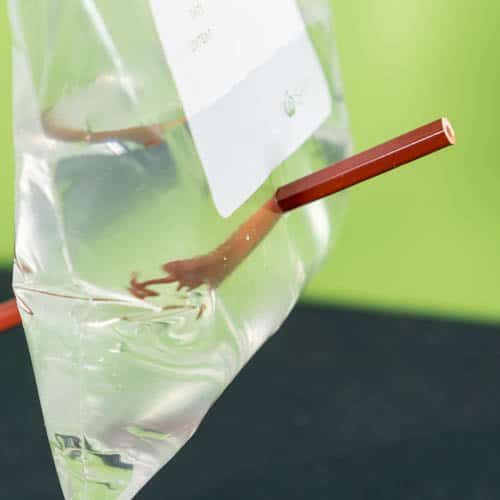
Hold up the ziplock bag and poke it with the sharp end of the pencil. Try fast vs. slow… which works better? Push the pencil all the way through the bag!
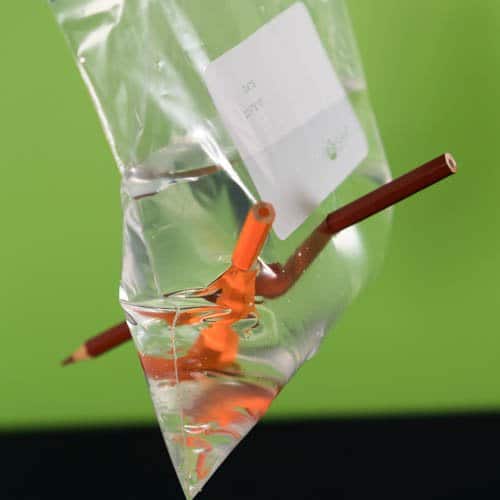
See how many pencils you can stab into the bag before it starts to leak!
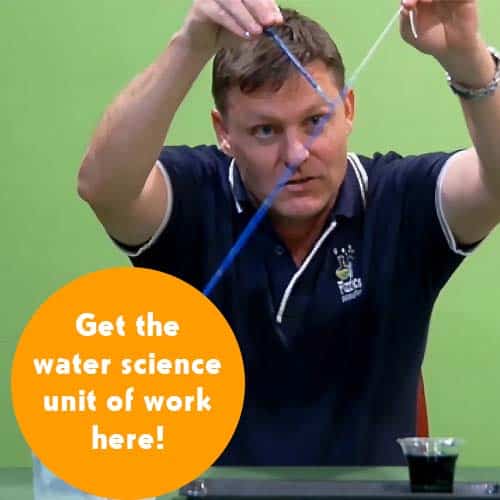
Get the Unit of Work on Water Science here!
- Explore the water cycle
- Learn about cohesion, adhesion & capillary action
- From water currents to floatation, join us to explore water science!
Includes cross-curricular teaching ideas, student quizzes, a sample marking rubric, scope & sequences & more
School science visits since 2004!
– Curriculum-linked & award-winning incursions.
– Over 40 primary & high school programs to choose from.
– Designed by experienced educators.
– Over 2 million students reached.
– Face to face incursions & online programs available.
– Early learning centre visits too!
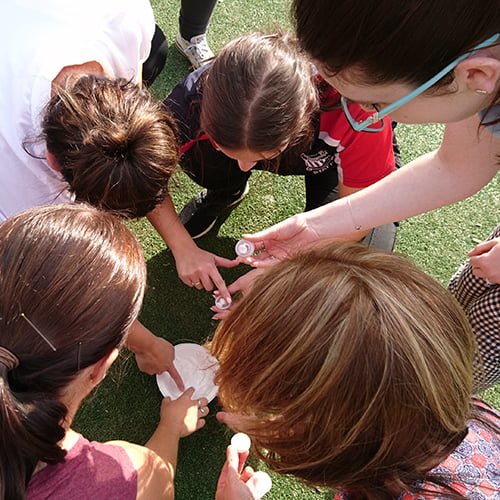
Online courses for teachers & parents
– Help students learn how science really works
Why does this work?
The bag is made from a flexible plastic polymer!
When you stab the pencils through the bag, the plastic polymer moves apart creating the hole. Once the pencil has moved through the hole, the polymer pushes back up against the pencil to create a temporary seal with friction.
Variables to test
More on variables here
- Does this make a difference with hot vs. cold water?
- Try different brands of zip-lock bags.
- Can you use thin vs. thick pencils?
- What about other objects like bamboo skewers, sewing needles or tomato stakes?

Learn more!
Working with water.
Years K to 2
Maximum 30 students
School workshop (NSW & VIC)
60 or 90 minutes
Online Class Available
Forces, Friction & Movement
Years K to 6
School workshop
STEM Full Day Accelerator - Primary
Designed from real classroom experiences, this modular day helps you create consistently effective science learning that directly address the new curriculum with easily accessible and cost-effective materials.
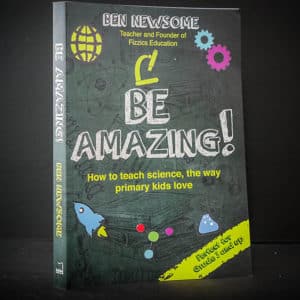
Be Amazing! How to teach science, the way primary kids love.
Love science subscribe.
Receive more lesson plans and fun science ideas.
SCIENCE PARTIES
Calendar of events.

HIGH SCHOOL Science@Home 4-Week Membership 12PM: March 2024
Price: $50 - $900

PRIMARY Science@Home 4-Week Membership 2PM: March 2024

Light and Colour Online Workshop, Jan 18 PM
Light and colour online workshop, jan 18 am.

Lego Robotics, Sydney Olympic Park Jan 2024

Creative Coding, Sydney Olympic Park Jan 2024

Creative Coding, Sydney Olympic Park July 11 2023
Price: $100

Fizzics Education STEAM Day: Robots vs Dinosaurs, Lalor, Apr 14
Price: $45 - $50
Creative Coding, Sydney Olympic Park April 14 2023
Science@home after school 4-week membership: march 2023.
Price: $40 - $1200
Leave a Reply Cancel reply
Your email address will not be published. Required fields are marked *
School Comments View All
Fizzics Education curated a thoughtful and hands-on experience for the children, incorporating practical, skill-based learning activities and followed by a science presentation at the end of the event involving liquid nitrogen. This was delivered safely and effectively, capturing both the children and the parents for the duration of the presentation.
Fizzics Education ran a show today at our school and it was wonderful. He was a great facilitator and the show was age appropriate and well done.
I just wanted to pass on how much the staff and students really enjoyed it and how perfect it was to launch our science week activities. The students were enthralled, educated and entertained – a perfect trifecta!
Thanks so much for presenting at our school on Monday. Our students enjoyed the show.
Fizzics Education Awards

- Free Resources
Free Chemistry Book! Sign-up to our newsletter and receive a free book!
Female Accountant Apply Here
Physics teacher apply here, science teacher apply here, view all vacancies, join our team apply here.
Send us an Email at [email protected]
Phone Number: 1300 856 828
Email: [email protected], address: unit 10/55 fourth ave blacktown, nsw 2148, australia.
- Privacy & Legal Policy
- Copyright Notice
- Terms of Trade
- Cookie Policy
Copyright 2024 Fizzics Education . All rights reserved.
This website uses cookies to improve user experience. By using our website you consent to all cookies in accordance with our Cookie Policy .
Get more science with our newsletter!
Thank you for looking to subscribing to our newsletter 🙂 Through this service you’ll be first to know about the newest free experiments, science news and special offers.
PLUS: Get a free Kitchen Chemistry Booklet with >20 experiments, how to use variables plus a handy template!
Click the image to preview
Please select an ebook!

Kids Edition

Parent Edition

Teacher Edition
Please fill out the details below and an email will be sent to you. Once you get that just click on the link to confirm your subscription and you're all done!
First Name *
Last Name *
Email Address *
Phone Number
Subscribe as a Teacher?
Preschool Teacher
Primary Teacher
High School Teacher
Vacation Care or Library
Subscribe as a Parent?
Enquiry Form
Extra things, products that might interest you.
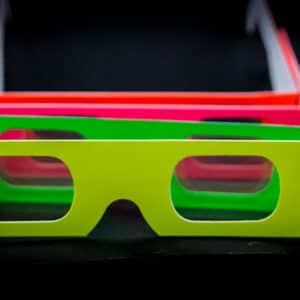
Rainbow Fireworks Glasses
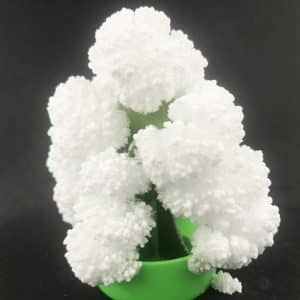
Magic Crystal Tree Science Kit

Helicopter Spiral Top

Fly Back Glider
- Grade Level
Where are you located?
- New South Wales
- Australian Capital Territory
Location not listed?
Which grade level are you teaching.
- Whole School
- Teacher Professional Development
- Special School Events
- Early Childhood
- Kindergarten
Which broad syllabus outcome you want to teach?
What is the age range of the attendee?
- Age 5 and up
- Age 6 and up
- Age 7 and up
- Age 8 and up
- Age 9 and up
- Age 10 and up
- Age 11 and up
- Age 12 and up
General Enquiry Form
Check if you require a live online class.
Subscribe for special offers & receive free resources?
How did you hear about us?
Choose a program *
Choose from school show *
* Please select a value!
* Please add a value!
Date required *
Time required *

IMAGES
COMMENTS
After all of the pencils are pushed through the bag, carefully open the bag and sprinkle in the superabsorbent powder. Give the powder a few seconds to solidify the water and remove the pencils. Use "The Leakproof Bag" as an object lesson for a message on school spirit and leadership. Let the bag of water represent the student body and use ...
a. The polymers in the plastic bag create a seal around the pencils. b. Water has magnetic properties which hold the bag together. c. The pencils attract all of the gravity so there is no gravity to pull the water out of the bag. d. The pencils do not actually create a hole in the bag, it is an optical illusion.
Before heading out the door, we gathered a few simple supplies to perform our leak proof bag trick: Zipper storage bag. Water. Several sharpened pencils. We filled the zipper storage bag about 2/3 full of water. After squishing out the air, we made sure the zipper was sealed tight. I asked my kids what they thought would happen if we stabbed a ...
How to Do the Leakproof Bag Experiment. This experiment is so easy to do! First, fill the plastic bags with water and seal them tightly. Next, take the bags outdoors or hold them over the bin. Ask the kids what they think will happen when you put the pencil through the bag. Many of them will think that the bag will leak right away.
Read the full experiment at http://www.stevespanglerscience.com/content/experiment/leak-proof-bag Who would have ever thought that a plastic bag, some water,...
Water. Make sure your pencils are really sharp. If they aren't, you might get leaks anyway. Fill the bag with water and seal it up tight. Hold the bag up and tell the kids to poke a pencil through. Some might hesitate, but go ahead and tell them to go for it. If they don't poke the pencil through with confidence, it might still leak.
Leak proof bag experiment for kids. Science experiment demonstrating polymers. Ages: Preschool, PreK, Kindergarten; Difficulty: Easy; ... Hypothesis: Let your child tell you what they think will happen when they put the pencil through the bag of water. Experiment: Time to stab the bag! Let them give the experiment a try and see what happens.
Instructions. Half fill the bag with water and seal it carefully. You need to be brave for the next part. Make sure your pencil is sharp and push through the bag, you don't need to be especially fast, slowly and carefully works well. Once you're done, show your audience your leak proof bag.
1. Fill the ziplock bag with water and close it up tightly. 2. Stick the sharp ends of the pencils or bamboo skewers through the bag. 3. Make sure the pencils or skewers go through to the other side. 4. Watch what happens. 5.
Science Grade School Kindergartners Preschoolers Experiment 9 Comments. The leak-proof bag experiment is a fun science experiment in which your kids get to poke pencils right through a plastic baggy filled with water.. Amazingly, the water doesn't come pouring out! This is a quick and easy experiment to set up too. Grab a sealable bag, any size will work.
LEAKPROOF BAG SCIENCE SAFETY PLEASE follow these safety precautions when doing any science experiment. ALWAYS have an adult present. ALWAYS wear the correct safety gear while doing any experiment. NEVER eat or drink anything while doing any experiment. REMEMBER experiments may require marbles, small balls, balloons, and other small parts.
The leak proof bag is a high interest activity to introduce your children to polymers, specifically a polymer called low-density polyethylene (LDPE). And if you don't care to get into the nitty gritty of the science, it just makes for a really fun experience. To do this activity, you will need to gather the following materials: a plastic bag ...
Leak Proof Bag Science Experiment. To begin, fill a gallon size storage bag about half full with water. Then poke a pencil straight through the bag - in one side and out the other. Much to everyone's surprise, the bag won't leak! This is because the bag is made of a polymer - which is long, flexible chains of molecules.
WHAT you will need for this Leak-Proof Bag STEM Experiment: a zip-lock bag. sharpened pencils. water. HOW to conduct this Pencil Arrows STEM Experiment: First, fill the zip-lock bag about 2/3 full of water. Next, squeeze out the air, and zip it closed. Thereafter, hold the bag up and, using the sharp end of one pencil, carefully poke the pencil ...
Leak-Proof Bag Experiment. April 28, 2020 | In Ages 3-4, Ages 4-5, ... Invite your child to form a hypothesis by saying: "I wonder what will happen if we pierce the bag with this pencil" - you can write down their hypothesis (for example, the water will pour out of the bag, or whatever they think will happen) ...
Zipper top plastic baggies (like the one used in our experiment), plastic grocery bags, plastic water, and soda bottles, and plastic food packaging are all made of polymers. Products made of polymers are flexible, lightweight, leak-proof, and low in cost to produce. Think of polymers as long chains of beads.
In the Leak-Proof Bag experiment, you will show the investigators how you can stick a bunch of pencils right through a baggie of water without gushing water all of the floor. There little faces will just light up when they will get to try it for themselves. The secret isn't magic; it's just the
The science behind it: Steve Spangler explains the leak proof bag science experiment works because plastic bags are made from polymers. Poking the pencils through the bag only separates the molecule chains, it doesn't break them. My 9 year old is only starting to understand the concept of molecules, so this was a great starting point for him.
If not, make sure you are over a sink or tub and have some towels handy. STEP 1. Make sure to start with freshly sharpened pencils if you can! STEP 2. Fill your plastic bag with water and seal tightly. STEP 3. Now for the fun part! Take a sharpened pencil and poke it through the bag! Don't hesitate or you may find it will leak a bit.
Leak-Proof Bag Experiment. This is a surprising science experiment that your child will surely be awestruck by! It involves poking sharpened pencils into a bag filled with water without spilling a drop. Geared toward preschoolers and kindergarteners, kids of all ages will feel like magicians as they poke pencils through the bag with no water ...
Instructions: Make sure the pencils are sharpened to a point. Fill a zipper-lock bag between ½ and ¾-full with water. Gather hypotheses. What would happen if you pushed a sharpened pencil through the water-filled bag? Holding the bag in one hand, use the other hand to slowly, but firmly, push one of the sharpened pencils through one side of ...
Hypothesis. Experiment. Conclusion. Inference. Pretest: Scientific Method. Which of these words would you not associate with the scientific method? Disorganized . Organized . Data. Control. Pretest: Scientific Method. ... Leak-Proof Bag Experiment Last modified by: User Company:
1. Fill the ziplock bag with water and close it. 2. Hold up the ziplock bag and poke it with the sharp end of the pencil. Try fast vs. slow… which works better? Push the pencil all the way through the bag! 3. See how many pencils you can stab into the bag before it starts to leak! 4.